 |
West Palm Beach |
 |
Code of Ordinances |
 |
Chapter 94. ZONING AND LAND DEVELOPMENT REGULATIONS |
 |
Article VII. SPECIAL DISTRICTS |
§ 94-210. Northwood mixed-use district (NMUD).
(a)
Intent . The Northwood mixed-use district (NMUD) is a compact, pedestrian-oriented, mixed-use district that serves Northwood, Pleasant City and other surrounding areas. This mixed-use district is characterized as having historically significant buildings with an eclectic mix of businesses, artist studios and shops. It provides for urban types of development regulations concerning setbacks, parking requirements and location, height limitations and permitted uses. The intent of the development standards for the Northwood mixed-use district is to reinforce the existing architectural character; to create a place of common vision and physical predictability for all new construction and renovations; to provide areas for the concentration of compatible land uses that are complementary to the surrounding neighborhoods; and to encourage historic preservation and a pedestrian friendly transit-oriented environment.
(b)
District boundaries . The development standards shall be utilized for properties located within the Northwood mixed-use district. The Northwood mixed-use district is generally bounded on the north by the alley north of 25th Street; Dixie Highway to the east; 23rd Street to the south; and the F.E.C. Railroad Tracks to the west.
(c)
Administration . In order to maintain predictability in development, planned developments and variances to increase building height or add stories are prohibited.
Variances from the dimensional requirements or waivers from any other criterion may be approved by the zoning board of appeals or the historic preservation board, provided that the applicant meets the standards pertaining to such variance or waiver. The zoning board of appeals shall hear and decide appeals where it is alleged there is an error in any order, requirement, decision, or determination made by the planning and zoning administrator in the enforcement of these development regulations.
(d)
General development standards .
(1)
In addition to the standards contained in this section, the standards in Section 94-209 Mixed Use (MU) district standards shall be applicable to development within the Northwood mixed-use district (MNUD).
(2)
The Northwood mixed-use district (NMUD) regulations consists of the regulating plans, diagrams and these mixed-use regulations.
(3)
The provisions of the NMUD regulations, when in conflict, shall take precedence over the general zoning and land development regulations.
(4)
The provisions of the building code, when in conflict, shall take precedence over the provisions of the NMUD regulations.
(5)
Existing buildings may not be destroyed or removed until a building permit has been issued for a replacement building which complies with the NMUD regulations.
(6)
Existing buildings and uses within the NMUD area, which were legally established but do not conform to current provisions of the NMUD regulations shall be considered legal nonconforming and may not be replaced, restored, or modified, except in conformity with the NMUD regulations, and shall follow the regulation for nonconformities contained in article XVI of this chapter. When a legal nonconforming structure is destroyed by windstorm, flood, or natural disaster, it may be replaced by a new structure of the same or lesser size, and reoccupied by the same use, if construction of such structure is commenced within 18 months of destruction.
(7)
Proposed development with a site plan approved under the 2002 NMUD regulations shall commence construction within the time frame allotted in the development order or site plan approval letter. If commencement of construction does not occur within the allotted time frame, the site plan approval shall automatically expire without further action by the city.
(8)
Surface parking. New permanent surface parking lots shall only be permitted on existing vacant lots that are owned by the city and/or the CRA or behind buildings that are consistent with the Northwood mixed-use district code requirements.
(e)
Civic buildings . The design of civic buildings shall be subject to these regulations.
(f)
Regulating plans and diagrams . The NMUD is governed by a series of regulating plans and diagrams. The regulating plans and diagrams demonstrate NMUD development standards in both words and diagrams, and include maps designating the locations where the various standards apply. Unless otherwise noted, all development shall be in compliance with the regulating plans and diagrams. The regulating plans and diagrams for the NMUD include the following:
(1)
The sub-districts regulating plan, which divides the NMUD into three subdistricts: core, transition and edge. The highest height and number of stories within the NMUD shall be allocated to the core sub-district. The height and number of stories shall then gradually decrease from the core to the transition sub-district and then further decrease to the edge sub-district which is characterized by single uses adjacent to existing low density residential. The sub-districts regulating plan is shown in Figure VII-1.
(2)
The building heights regulating plan, which establishes the maximum building height as shown in Figure VII-2.
(3)
The designated open spaces and urban greenway systems regulating plan, which designates the required public open spaces and urban greenway system as shown in Figure VII-3.
(4)
The street network connectivity regulating plan, which shows the location of existing and the required new streets needed to create the prescribed network of streets within the NMUD. This plan also establishes the hierarchy of the streets as shown in Figure VII-4.
(5)
The building typology and placement regulating diagrams, which provide a schematic representation of the various building typologies. The diagrams demonstrate the required lot standards and profiles of structures. The building typology and placement regulating diagrams are shown in Figures VII-5 through VII-12.
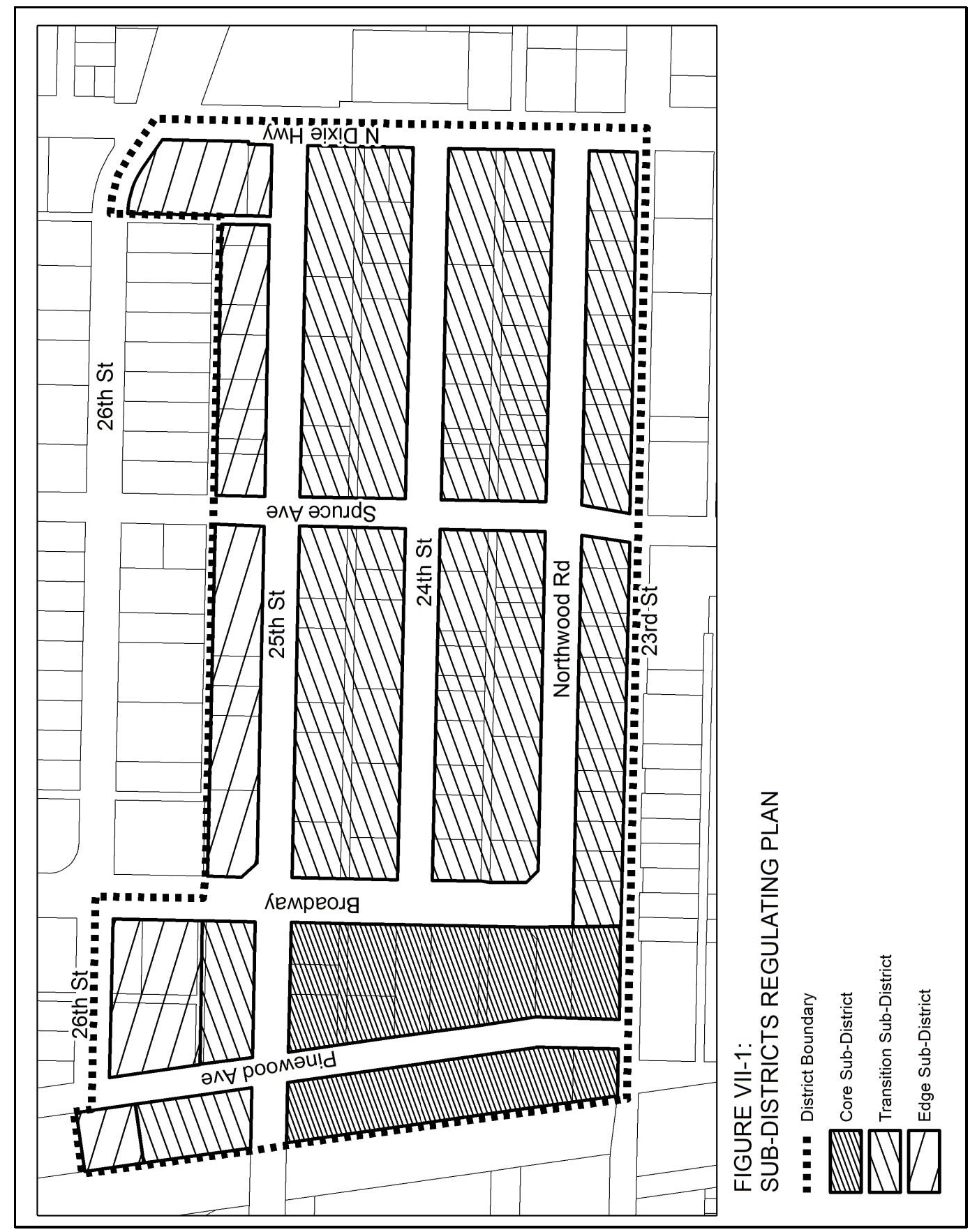
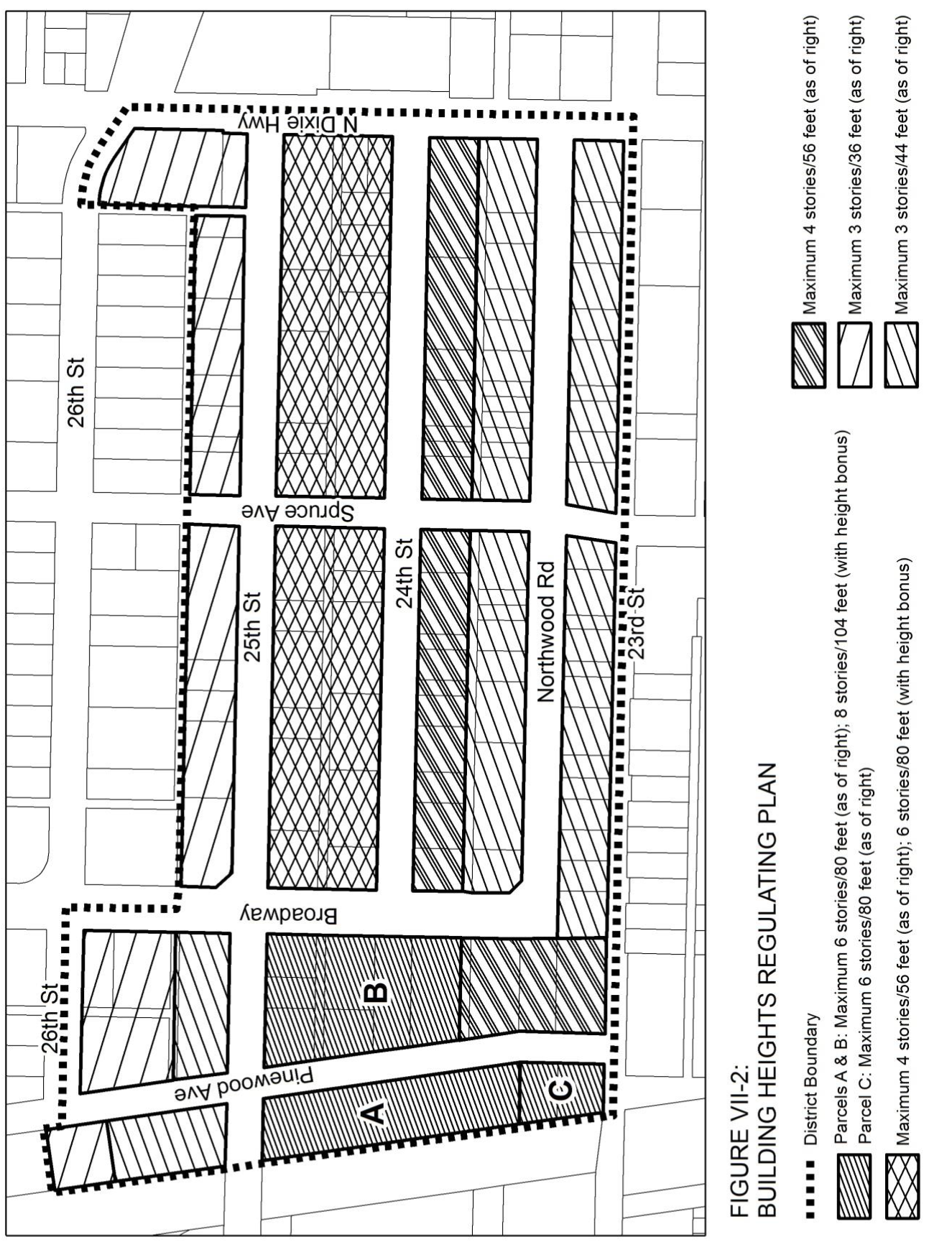
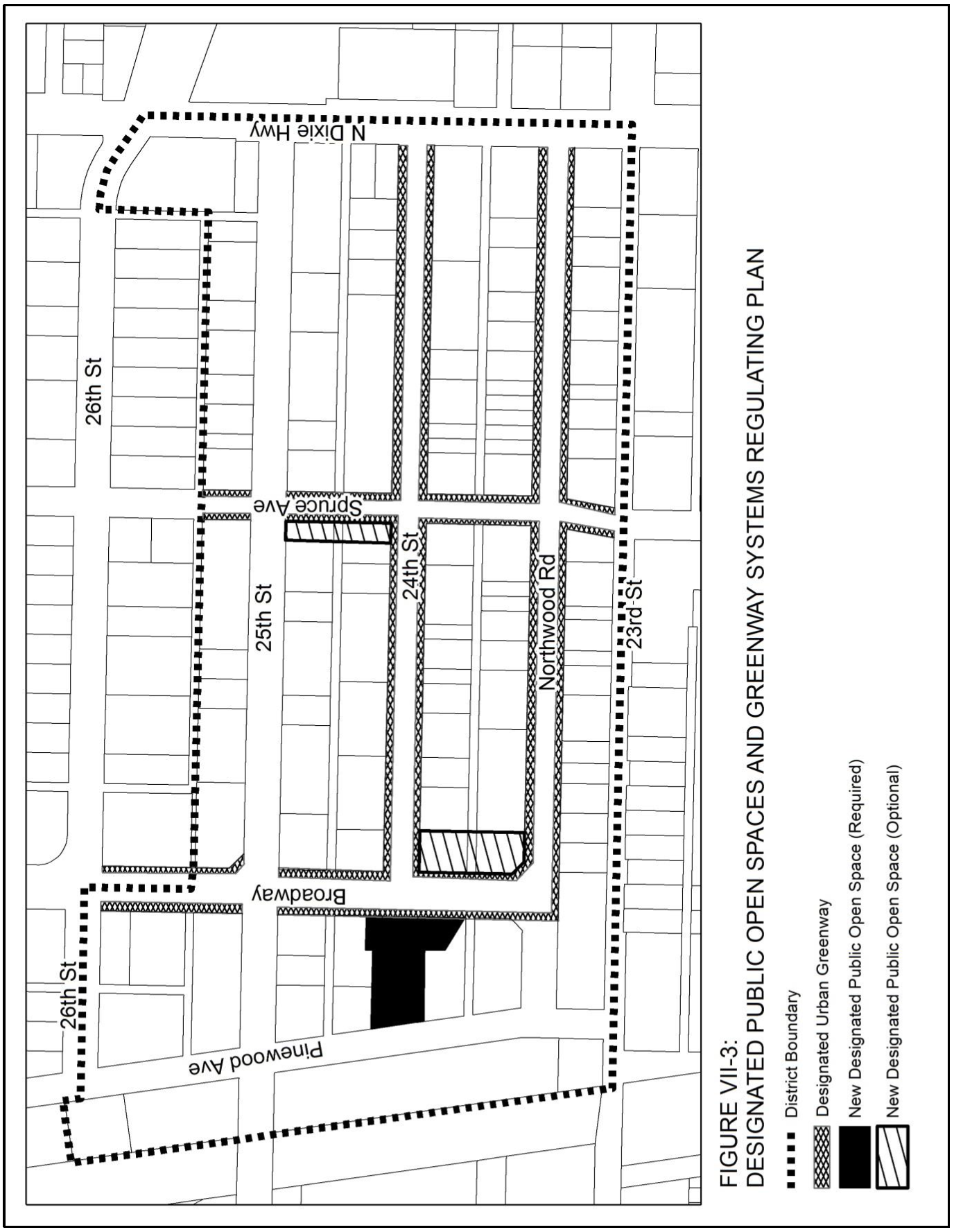
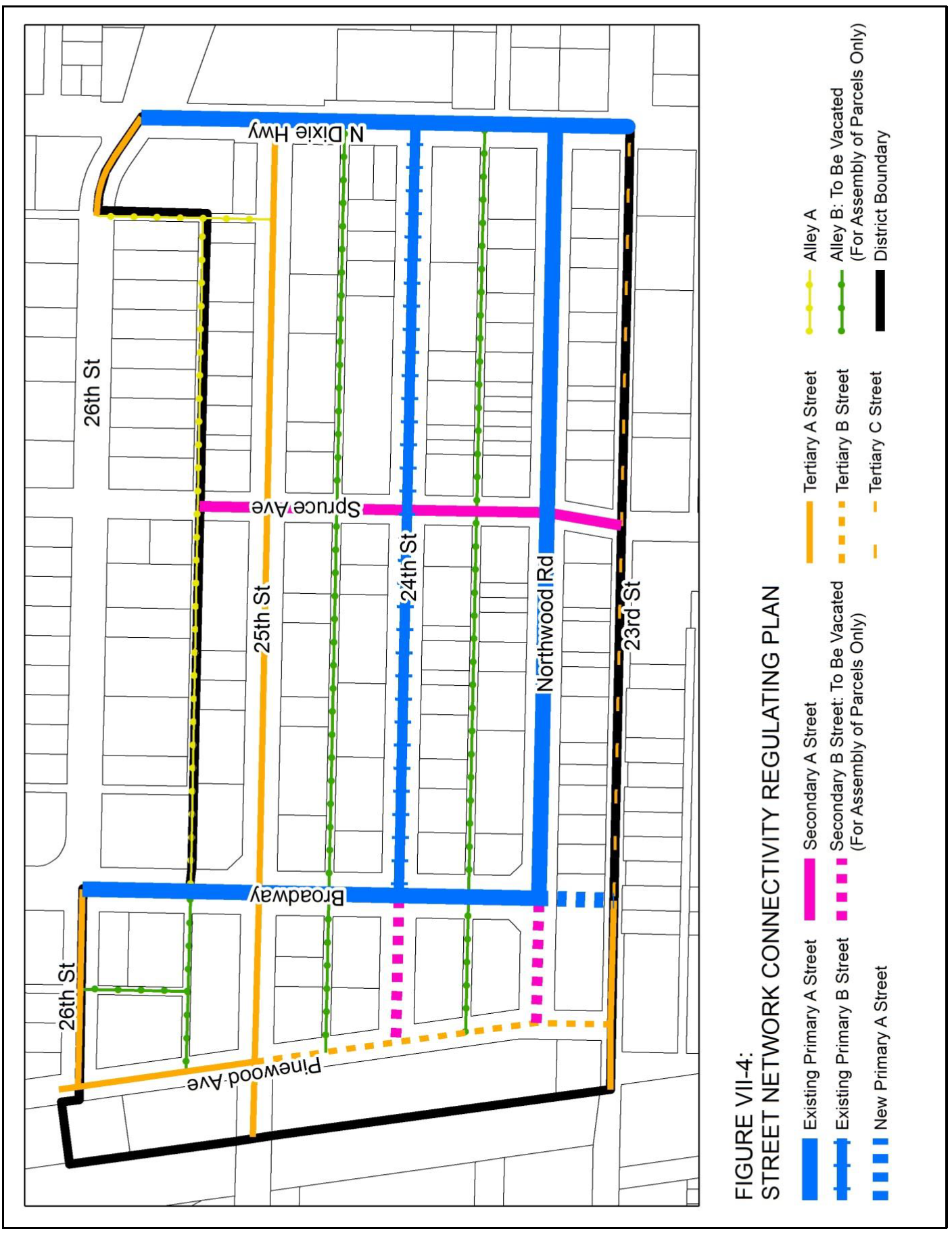
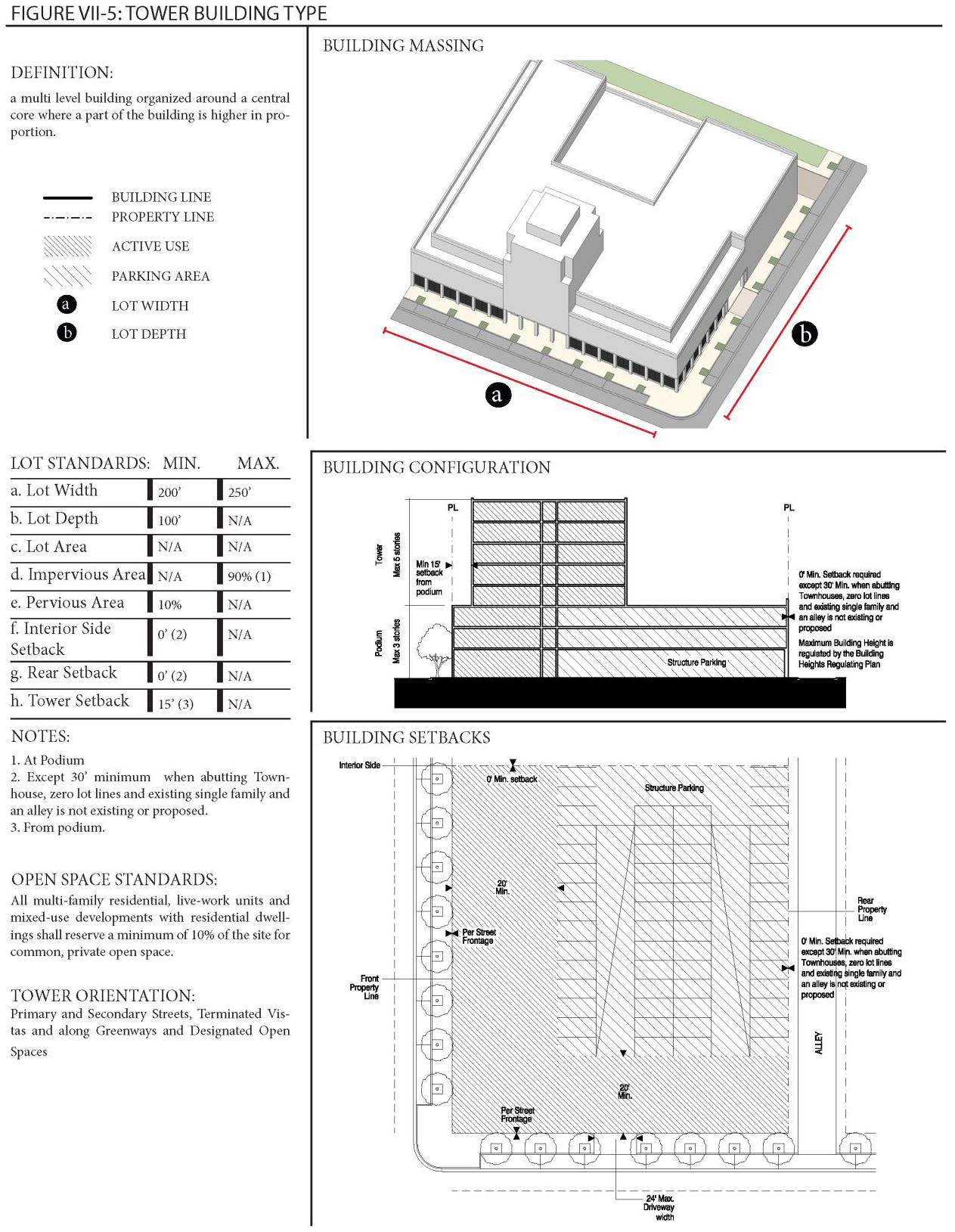
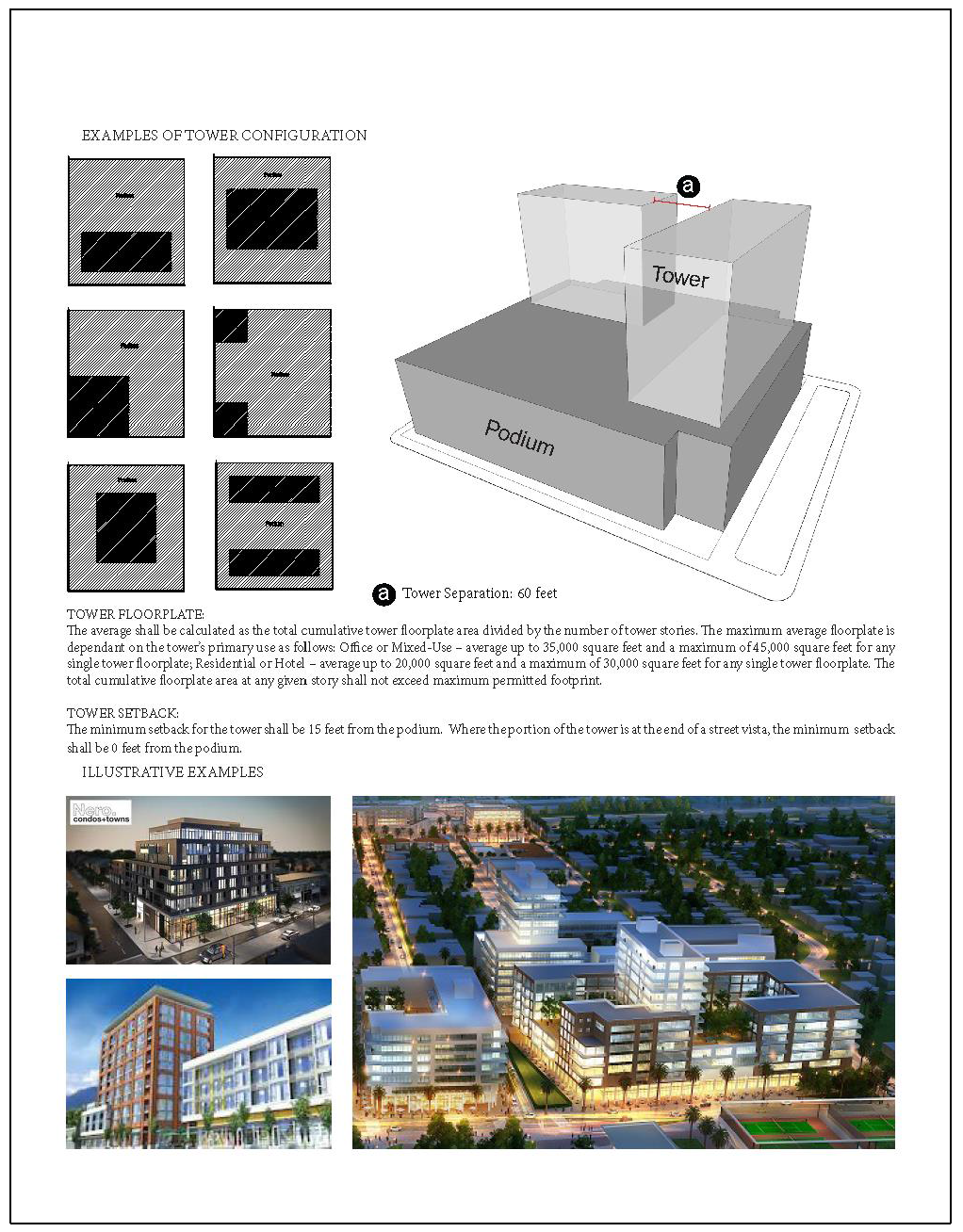
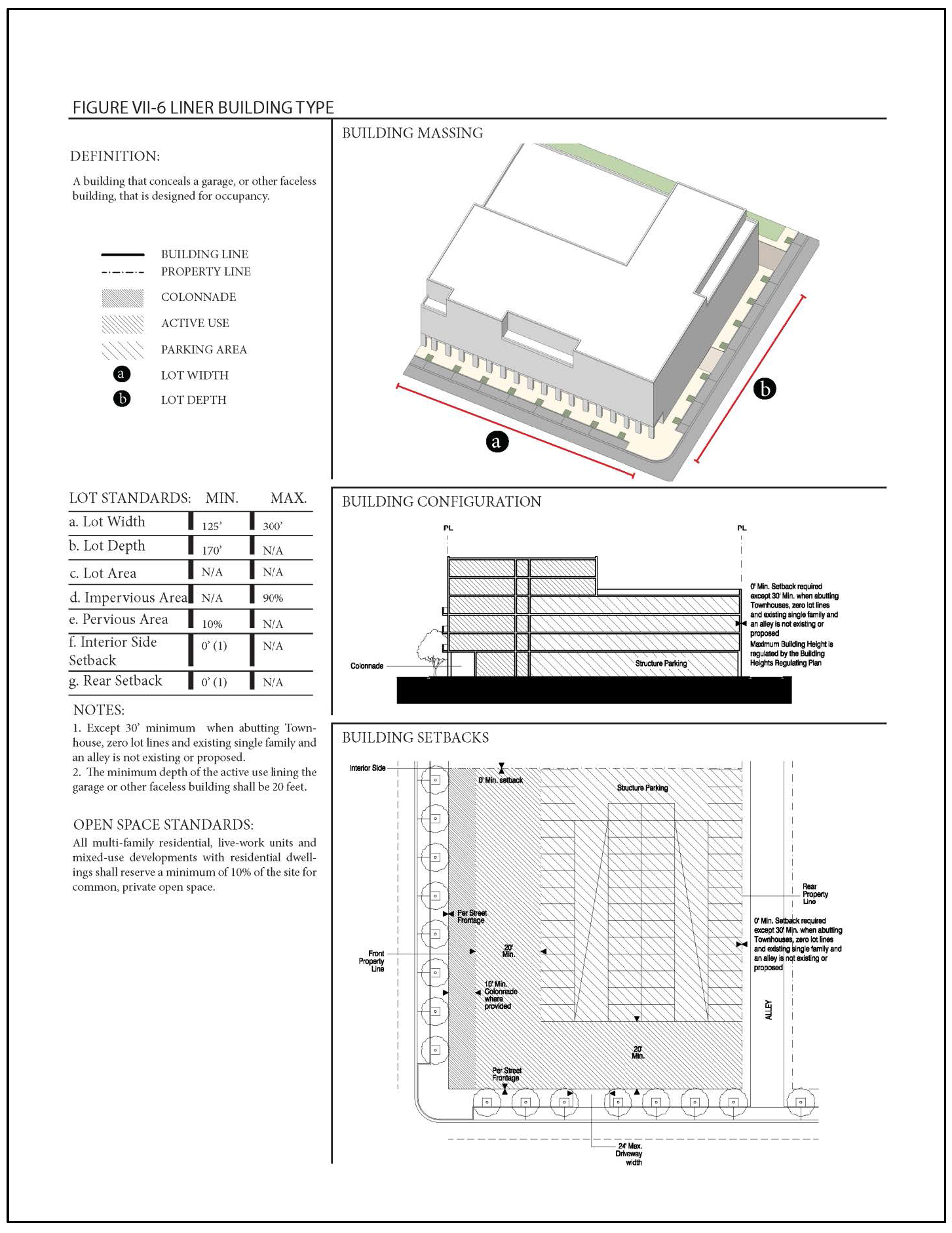
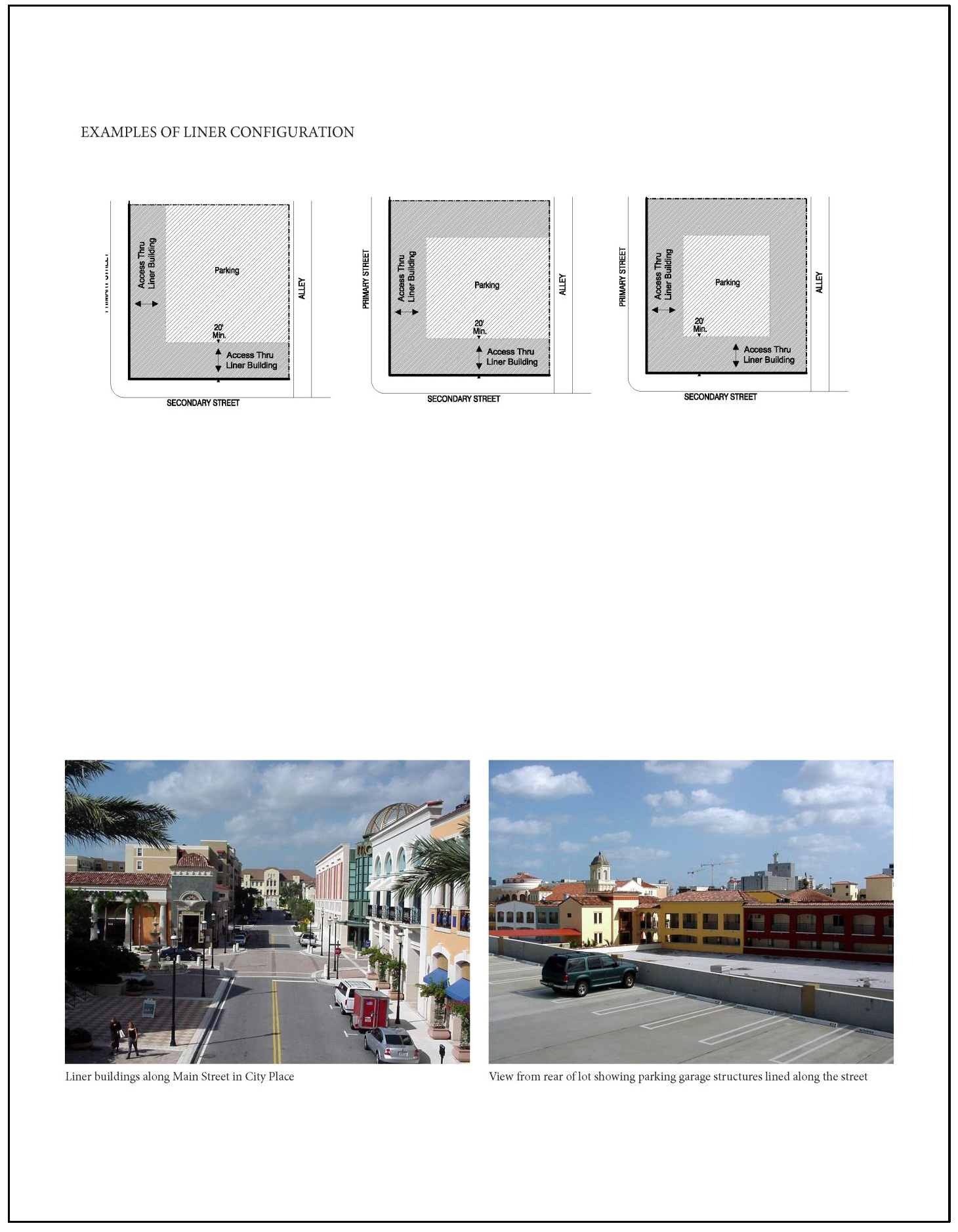
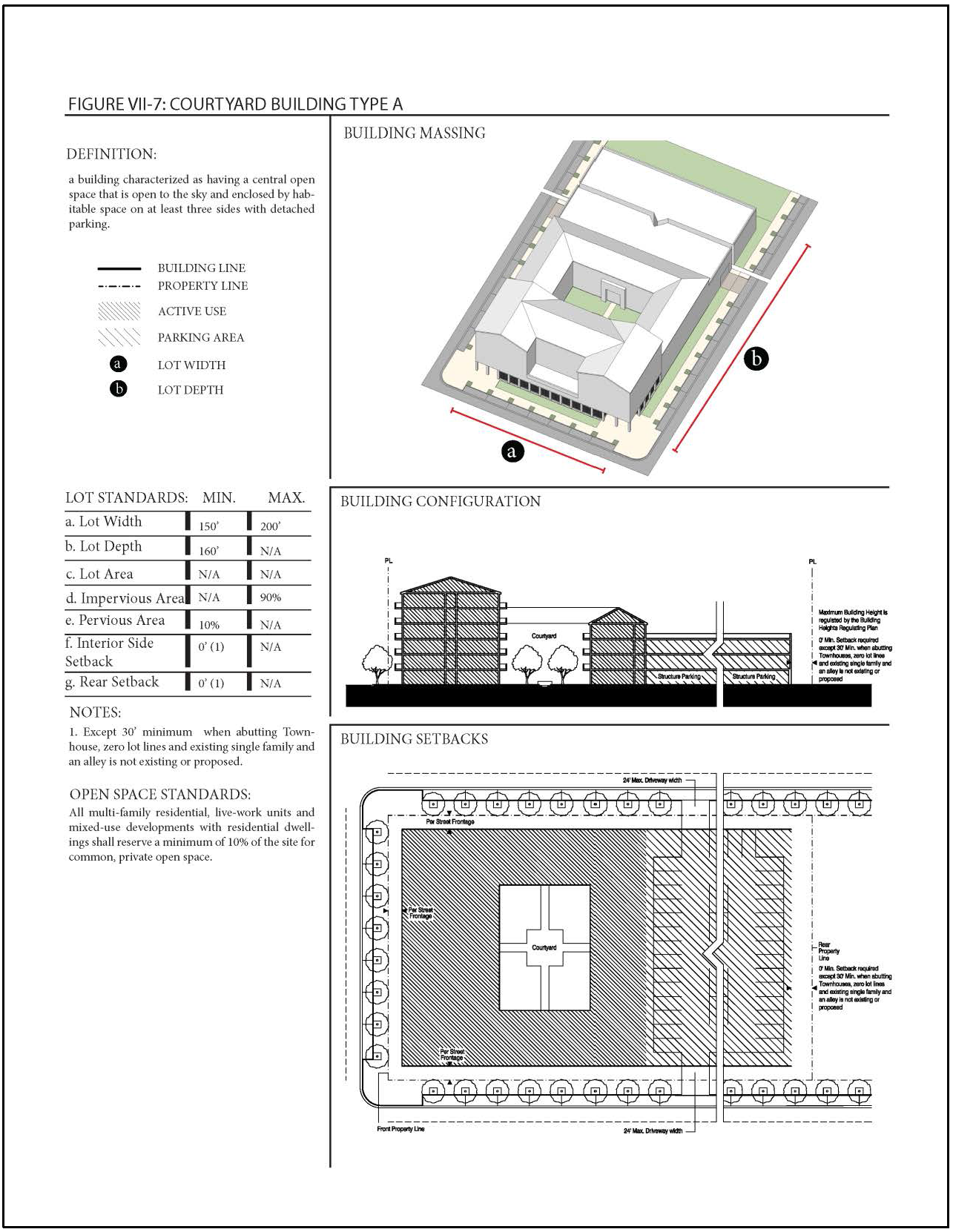
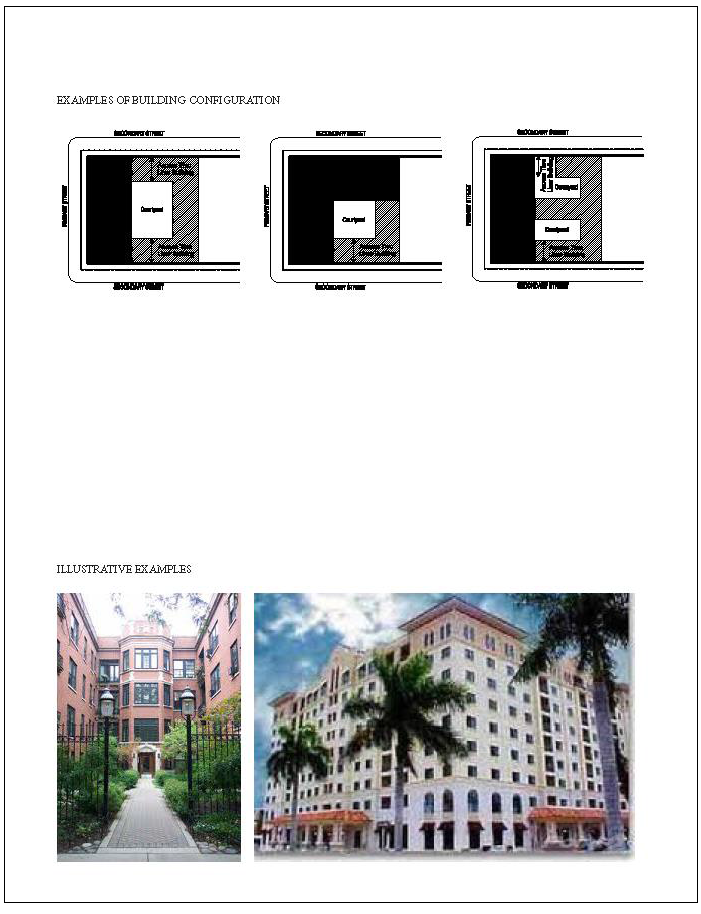
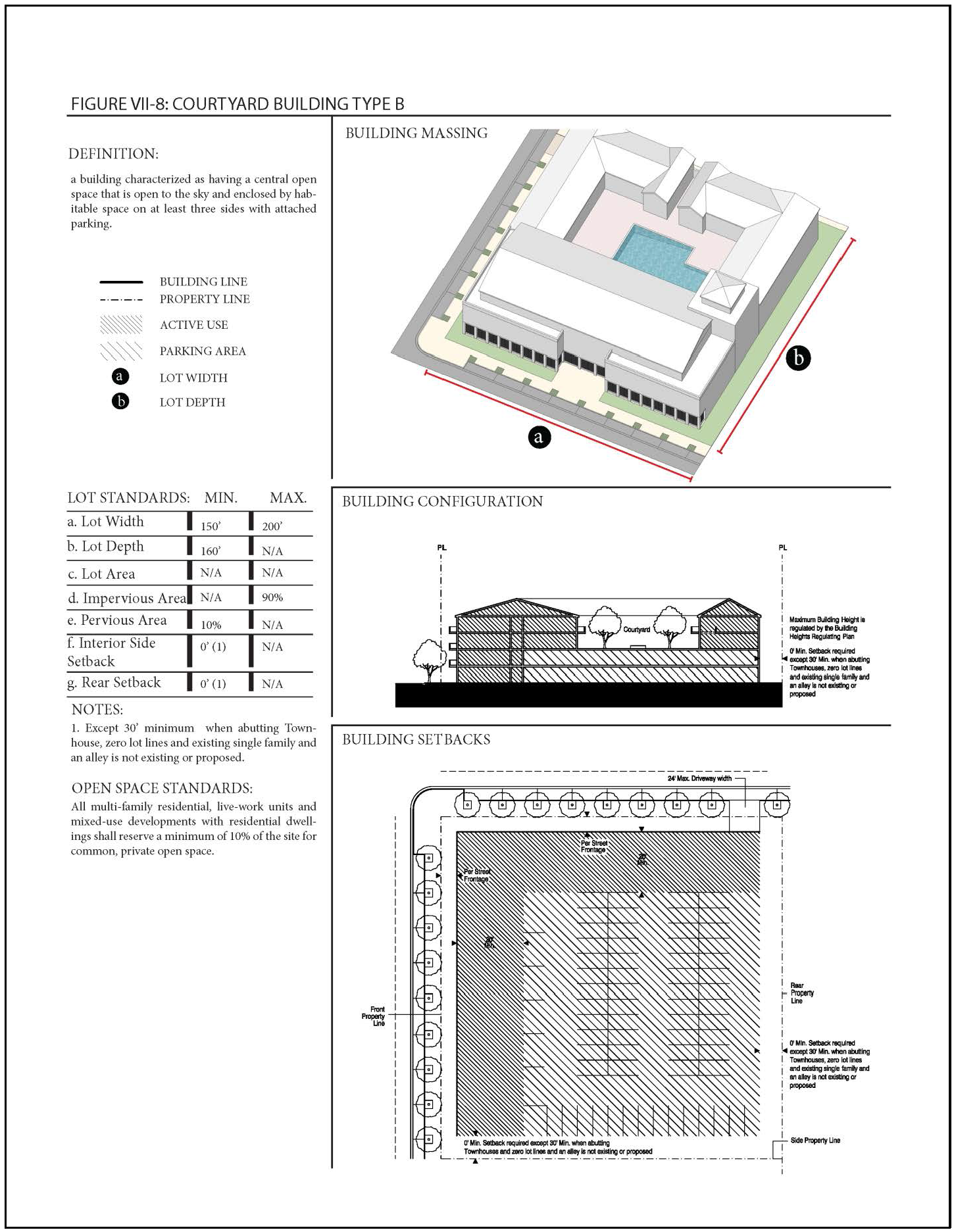
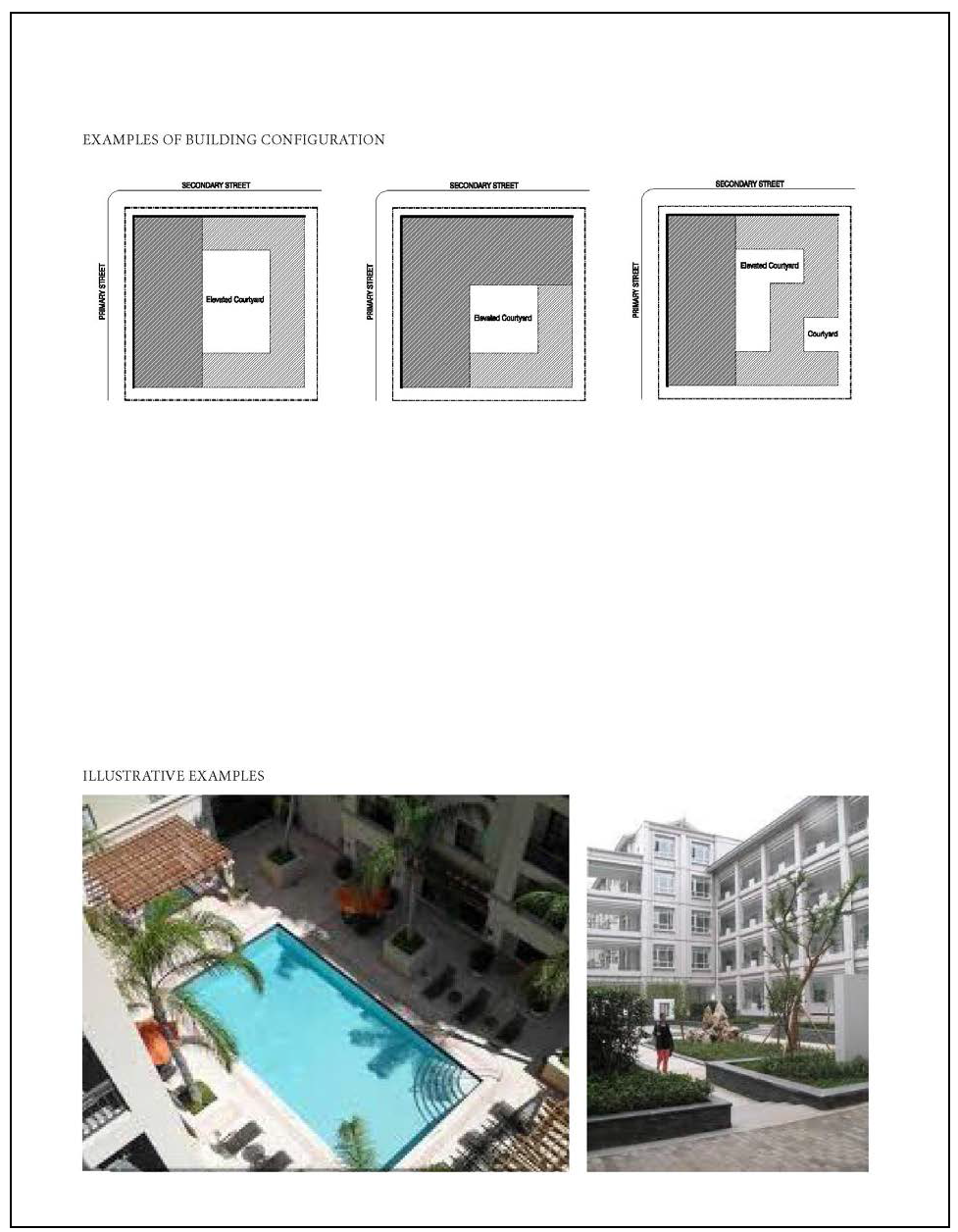
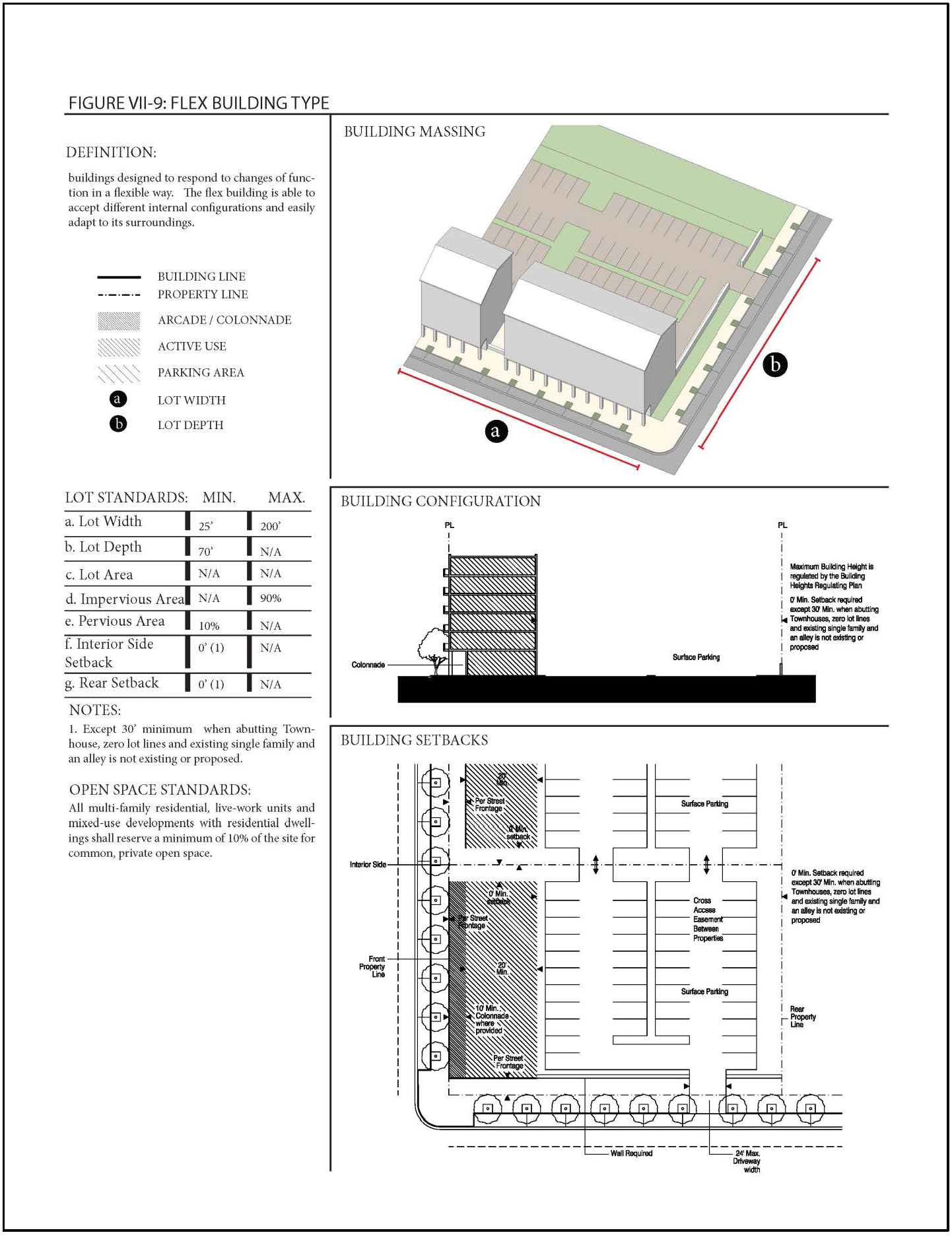
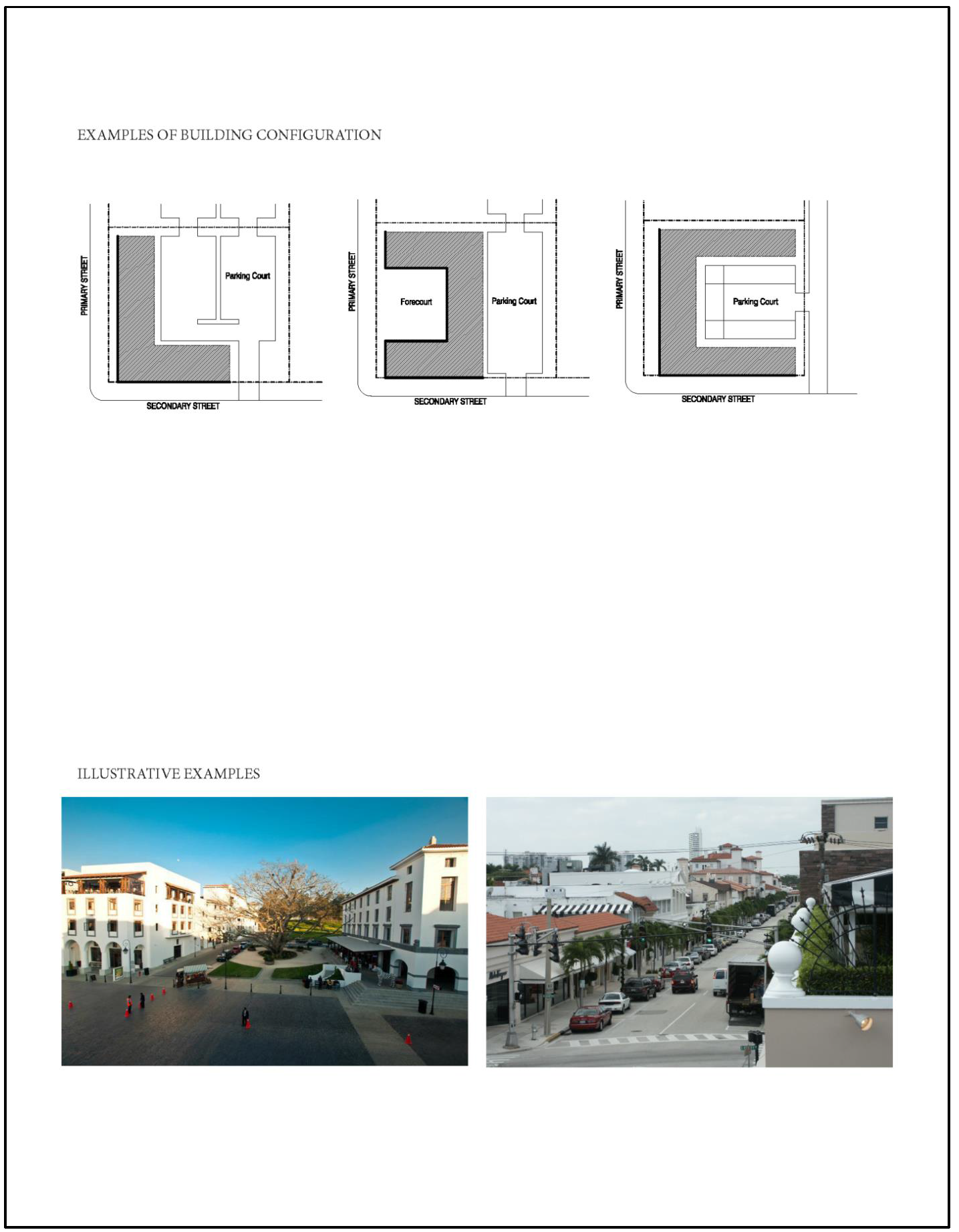
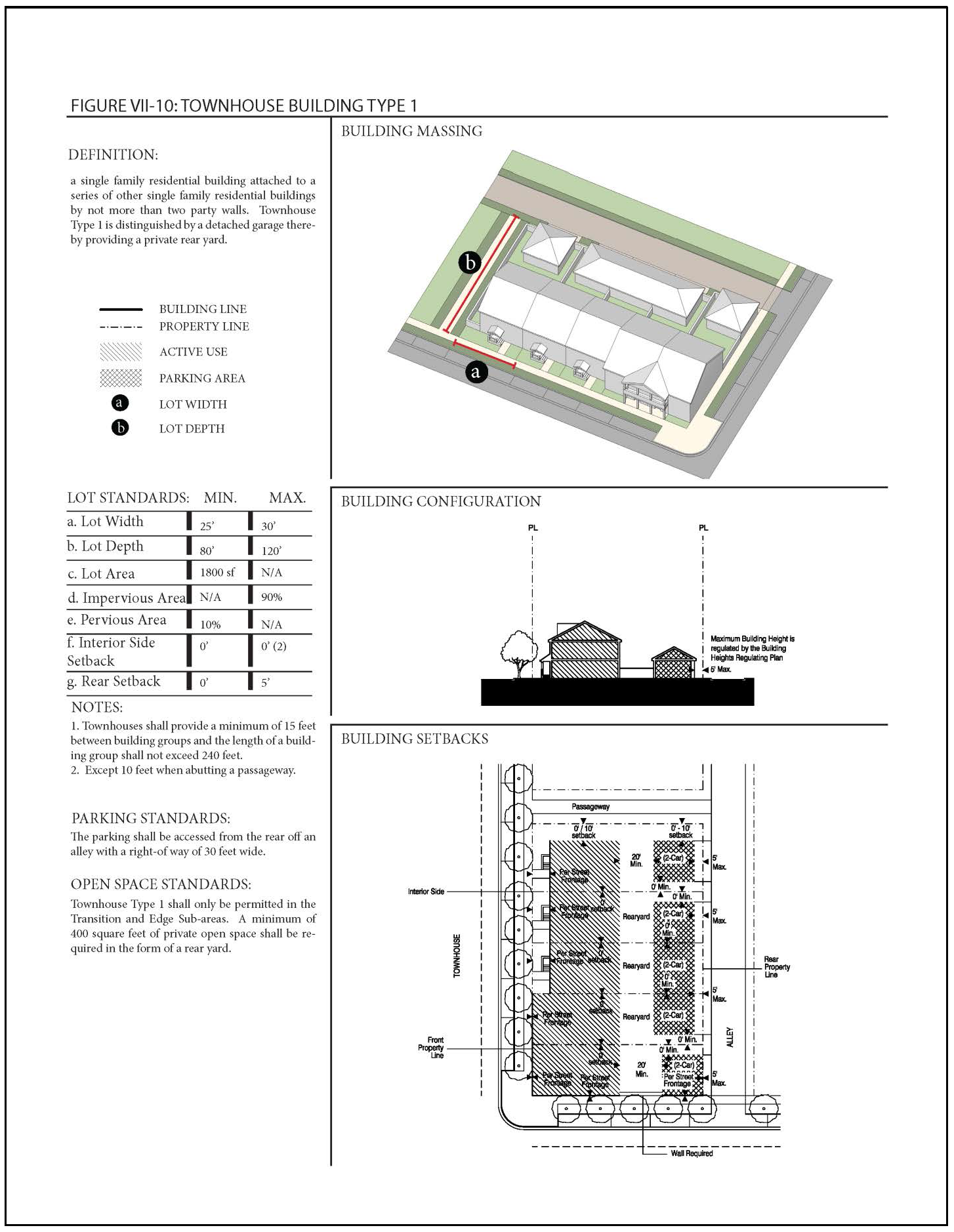
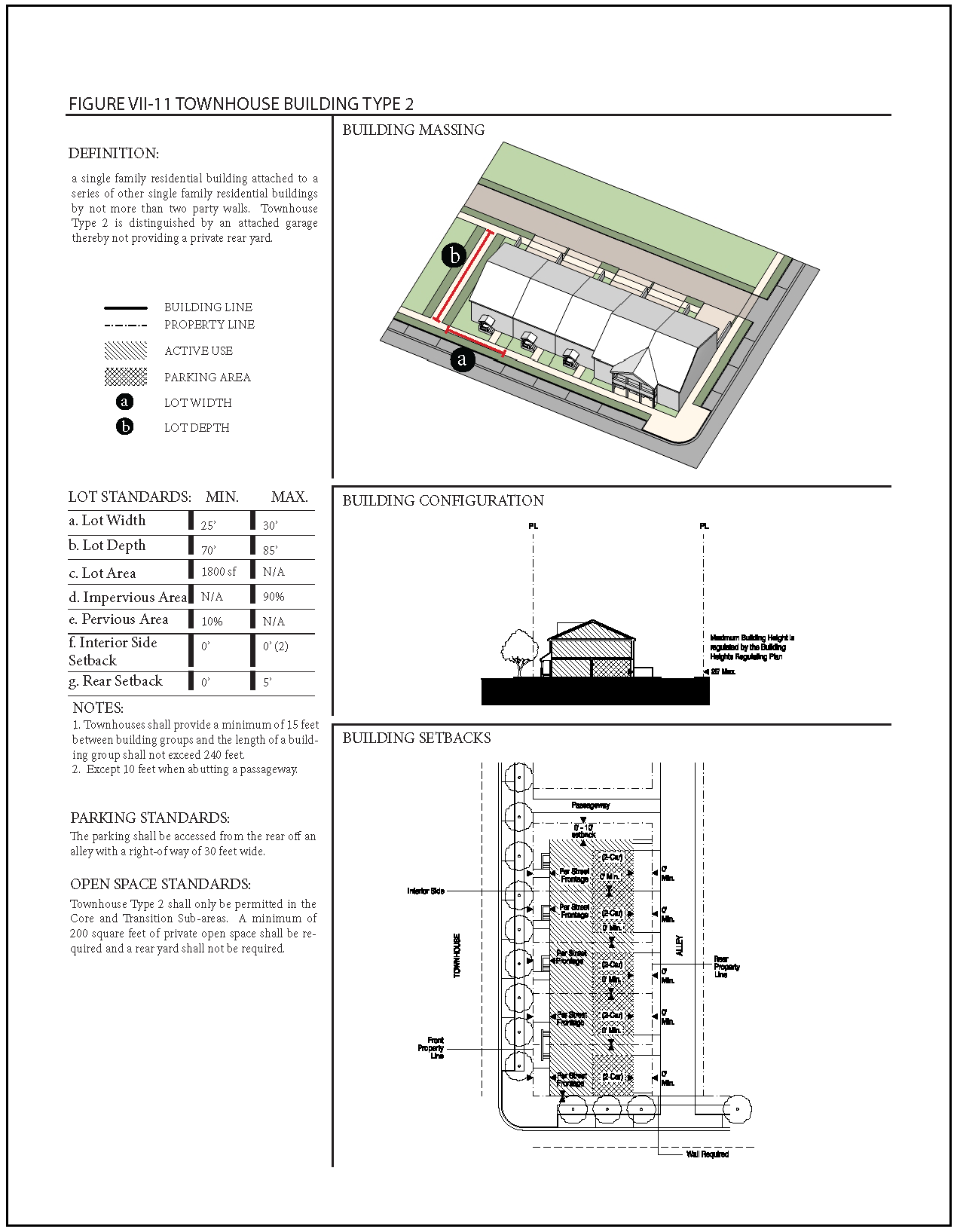
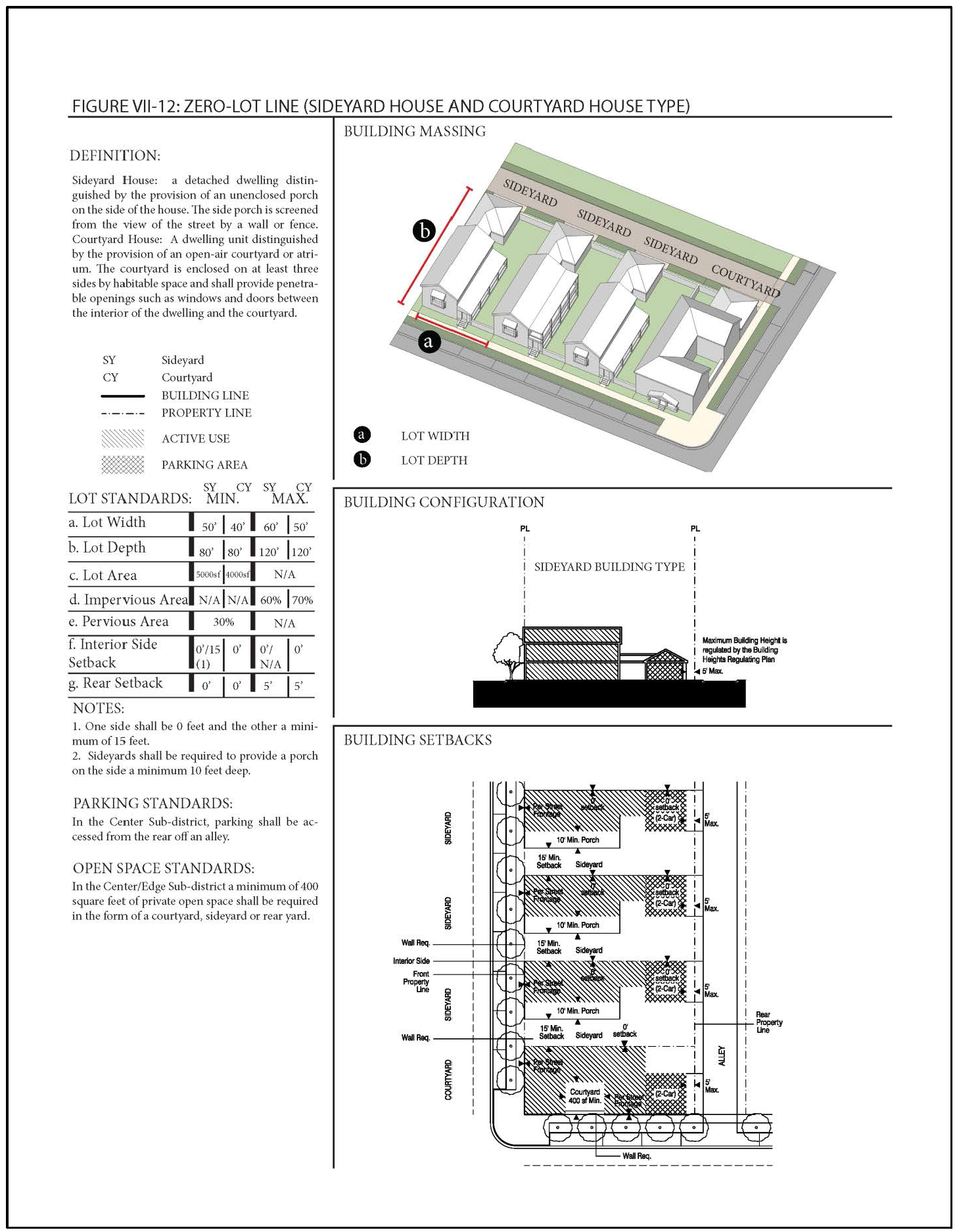
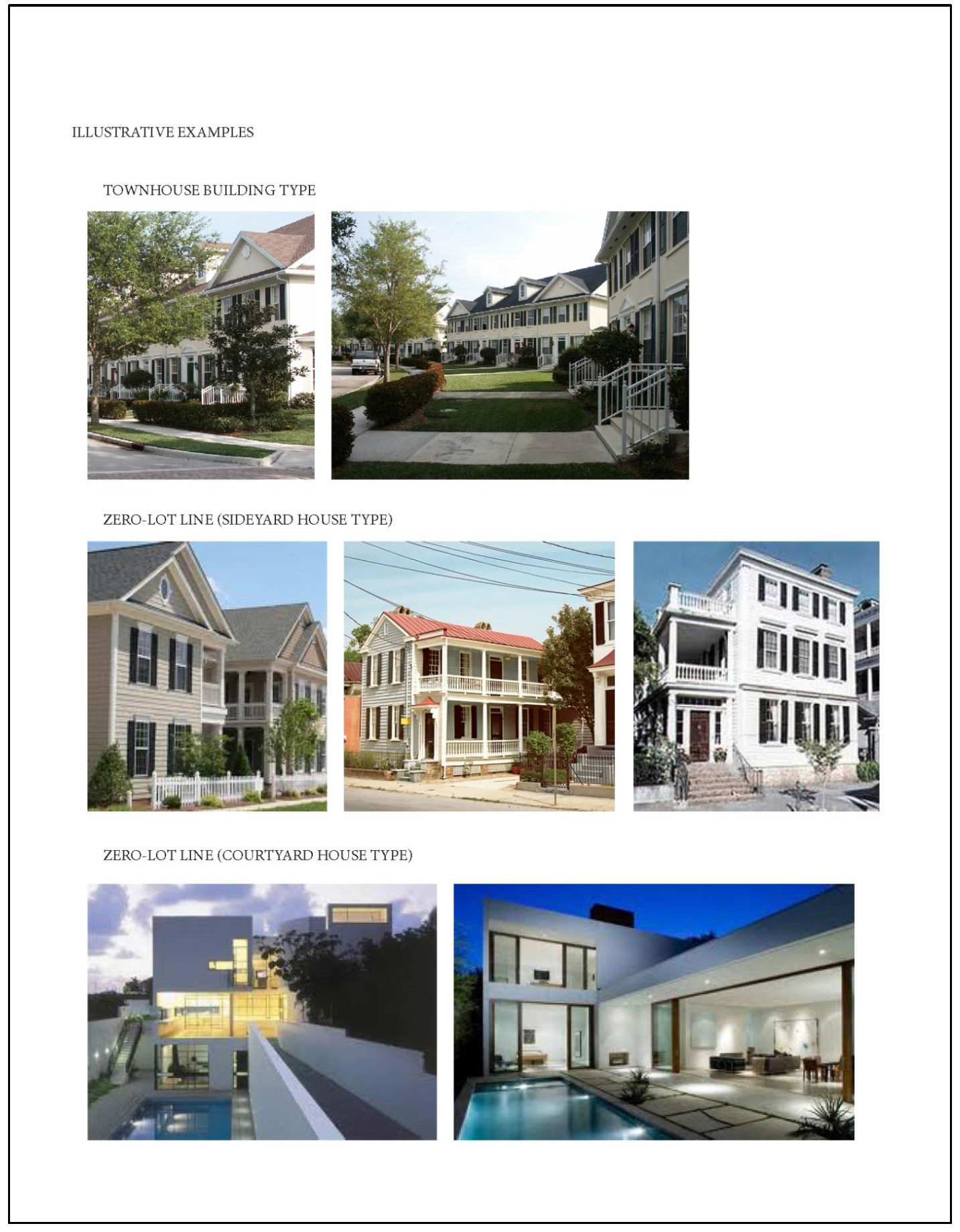
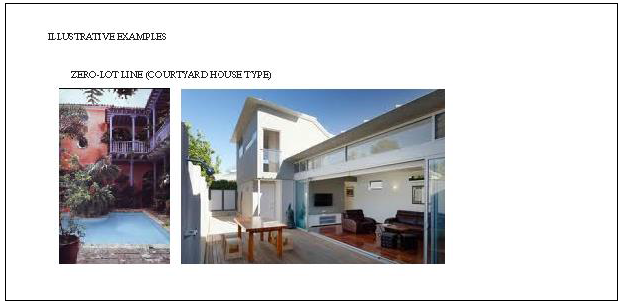
(g)
Sub-districts regulating plan . All new and existing development shall review first their location within the sub-districts regulating plan as shown in Figure VII-1.
(h)
Building heights regulating plan and additional height standards .
(1)
Building heights regulating plan . All new and existing development shall comply with the standards found within the building heights regulating plan as shown in Figure VII-2. Table VII-2 provides a listing of the heights per sub-district; however, since maximum building heights vary within the sub-districts and are dependent on location and/or bonus provisions, the building height regulating plan shall be referred to.
Table VII-2: Maximum Permitted Height (1)
Area Maximum Permitted Height Core Sub-district 4 stories/ 56 feet (1)
6 stories/ 80 feet (1)
8 stories/ 104 feet (2)Transition Sub-district 3 stories/ 44 feet (1)
4 stories/ 56 feet (1)
6 stories/ 80 feet (2)Edge Sub-district 3 stories/36 feet (3) Notes:
(1) Maximum allowable height as of right
(2) Maximum allowable height utilizing height bonus option
(3) Maximum allowable height adjacent to Northwood Historic District. In the edge sub-district, vertical projections shall be permitted a maximum height encroachment of five (5) feet.(2)
Height bonus option .
a.
Properties within Parcels A and B of the Core sub-district have a maximum allowable base height of six stories/80 feet as of right and are eligible for a height bonus. Height bonuses shall be granted in accordance with Figure VII-2, Building Heights Regulating Plan and Table VII-3, Height Bonus in the Core Sub-district, provided that the following conditions are met:
i.
Buildings greater than six stories in height shall follow the development standards of the tower building type as established by these regulations.
ii.
Except for allowable height encroachments, the building height shall not exceed eight stories/104 feet.
Table VII-3: Height Bonus in the Core Sub-district
Bonus Option Height Bonus Requirement 1 2 stories/24 feet Properties that contribute to the Northwood Historic Preservation Fund in accordance with Section 94-210(h)(3)(a). b.
Properties located between 24 th and 25 th Streets within the Transition sub-district have a maximum allowable base height of 4 stories/ 56 feet and are eligible for a height bonus. Height bonuses shall be granted in accordance with Figure VII-2, Building Heights Regulating Plan and Table VII-4, Height Bonus in the Transition Sub-district, provided that the following condition is met:
i.
Except for allowable height encroachments, the building height shall not exceed six stories/80 feet.
Table VII-4: Height Bonus in the Transition Sub-district
Bonus Option Height Bonus Requirement 1 2 stories/24 feet Properties that designate and preserve an existing structure on-site and/or contribute to the Northwood Historic Preservation Fund in accordance with Section 94-210(h)(3)(a). 2 2 stories/24 feet Properties that develop and maintain in perpetuity new dedicated public open spaces a minimum of ten percent of the lot area in accordance with Section 94-210(k). (3)
Height bonus requirements . Developments requesting a height bonus within the core and transition sub-districts shall comply with the requirements for the specific height bonus requested, as listed below:
a.
Historic preservation . Developments that designate and preserve an existing structure on-site per section 94-46 thru section 94-53 (historic preservation guidelines) and article IV (Tax Exemption for Historic Properties) and/or contribute to the Northwood Historic Preservation Fund in accordance with sections 94-210(q) and 94-210(r) shall be eligible for the maximum allowable height incentive for the sub-district.
(i)
Building typology and placement regulating diagrams and dimensional standards .
(1)
Building typology . All new buildings shall conform to one of the permitted building typologies. The building typologies are demonstrated in the building typology and placement regulating diagrams as shown in Figures VII-5 thru VII-12. The diagrams provide a schematic representation of the various building typologies and demonstrate the required setbacks, lot standards, and profiles of structures. Not all building typologies are permitted in each sub-district. Additions, alterations or modifications to existing buildings which do not fit a prescribed typology, shall follow the standards required for the Flex building typology. The building typologies permitted in the NMUD and their allowable sub-district locations are listed below in Table VII-5:
Table VII-5: Building Typologies
Building Typology Core Transition Edge Tower Yes No No Liner Yes Yes No Courtyard Building Yes Yes No Flex Yes Yes Yes (1) Townhouse Type 1 No Yes (2) Yes (3) Townhouse Type 2 No Yes (2) Yes (3) Zero Lot Line (Courtyard House) No No Yes(4) Zero Lot Line (Sideyard House) No No Yes(4) Notes:
(1) Non-residential buildings shall have their principal frontage facing Broadway, Pinewood Avenue, N. Dixie Highway or 25 th Street.
(2) 25 th Street (west of Broadway) and Pinewood Avenue (north of 25 th street) only.
(3) Townhouses are not permitted to have their principal frontage facing Spruce Avenue.
(4) Only permitted with the principle frontage facing 26 th Street, between Broadway and Pinewood Avenue.(2)
Setbacks and building frontage .
a.
Setbacks and building frontage . Setbacks are determined based on the street the building fronts. Table VII-6 lists the minimum required setbacks and building frontage per street type.
i.
For purposes of the building frontage, in the Core and Transition sub-districts a forecourt shall be considered as a principal building. The portion of the building fronting the forecourt may be set back up to 25 feet from the property line to accommodate a forecourt.
Table VII-6: Minimum and Maximum Setbacks per Building Frontage per Street Type (1)
Street Type Minimum Setback Maximum Setback Building Frontage Primary A - Broadway Avenue In the Core Sub-district: 10 feet
In the Transition and Edge Sub-districts: 5 feetIn the Core Sub-district: 20 feet
In the Transition and Edge Sub-districts: 10 feet90% Primary A - Northwood Road 0 feet 5 feet 90% Primary A - N. Dixie Highway In the Transition Sub-district: 0 feet
In the Edge Sub-district: 5 feetIn the Transition Sub-district: 5 feet
In the Edge Sub-district: 10 feet70% Primary B (24 th Street east of Broadway Avenue) 0 feet 10 feet 80% Secondary A and B 0 feet 10 feet 80% Tertiary A Along 25 th Street: 0 feet
Along Pinewood Avenue: 5 feet
Along 23 rd and 26 th Street: 10 feetAlong 25 th Street: 10 feet
Along Pinewood Avenue: 5 feet
Along 23 rd and 26 th Street: 20 feetAlong 25 th Street: 70% Pinewood Avenue: 50%
Along 23 rd and 26 th Street: 50%Tertiary B 0 feet 10 feet 50% Tertiary C 0 feet N/A N/A Alley A and B Per Building Typology and Placement Regulating Diagrams Per Building Typology and Placement Regulating Diagrams N/A Notes:
(1) Setbacks are measured from property lines.b.
Interior side and rear/alley setbacks . Interior side and rear/alley setbacks are determined based on the building typology. Table VII-7 lists the minimum interior side and rear/alley setbacks based on building typology.
Table VII-7: Interior Side and Rear/Alley Setbacks By Building Type (1)
Building Type Interior Side Rear/Alley Setback Notes Min. (No Max.) Min. Max. Tower (At Podium Level) 0 0 (3) 15 (4) N/A Liner 0 0 (3) 15 (4) N/A 30 ft. Min. required when abutting townhouses, zero-lot lines and existing single family residential and an alley is not existing or proposed Courtyard Building A&B 0 0 (3) 15 (4) N/A 30 ft. Min. required when abutting townhouses, zero-lot lines and existing single family residential and an alley is not existing or proposed Flex 0 0 (3) 15 (4) N/A 30 ft. Min. required when abutting townhouses, zero-lot lines and existing single family residential and an alley is not existing or proposed Townhouse Type 1 0 (2) 0 (3) 10 (4) 5 (3) 15 (4) N/A Townhouse Type 2 0 (2) 0 (3) 10 (4) N/A N/A Zero-Lot Line (Courtyard House) 0 0 (3) 10 (4) 5 (3) 15 (4) N/A Zero-Lot Line (Sideyard House) 0 / 15 0 (3) 10 (4) 5 (3) 15 (4) One side shall be 0 feet and the other shall be a minimum of 15 ft. Note:
(1) Setbacks shall be measured from property lines.
(2) Except 10 feet when abutting a pedestrian passageway.
(3) When a 30 feet alley is existing or proposed.
(4) When a 15 feet alley is existing or proposed.c.
Tower regulations .
i.
Tower floorplate standard . The average shall be calculated as the total cumulative tower floorplate area divided by the number of tower stories. The maximum average floorplate is dependent on the tower's primary use as follows: Office or Mixed-Use - average up to 35,000 square feet and a maximum of 45,000 square feet for any single tower floorplate; Residential or Hotel - average up to 20,000 square feet and a maximum of 30,000 square feet for any single tower floorplate.
ii.
Tower separation . The minimum allowable horizontal distance between two or more tower floorplates shall be 60 feet.
iii.
Tower orientation . The placement of the tower shall be such that it is near, fronting or adjacent to, and oriented toward a specified Primary Street, Urban Greenway or Designated Open Space.
(3)
Lot standards . Lot standards, including but not limited to lot dimensions and impervious surface area, are determined based on the selected building typology. Table VII-8 lists the lot standards.
a.
For full block developments, which are bounded by streets or a railroad on all sides, in the Core and Transition sub-districts only, the minimum and maximum lot width and lot depth do not apply.
Table VII-8: Lot Standards By Building Type
Building
Type
Lot Standards Additional
NotesLot Width (Ft.) Lot Depth (Ft.) Impervious Surface Area Lot Area (SF) Pervious Surface Area Private Open Space Min. Max. Min. Max. Max. Min. Min. Tower 200 250 100 (1) 170 (2) N/A 90% 20,000 10% All multifamily residential, live-work units and mixed-use developments with residential dwellings shall reserve a minimum of 10% of the site for common, private open space. No minimum lot area required for full block developments Liner 125 300 100 (1) 170 (2) N/A 90% 12,500 10% All multifamily residential, live-work units and mixed-use developments with residential dwellings shall reserve a minimum of 10% of the site for common, private open space. No minimum lot area required for full block developments Courtyard Building 150 200 100 (1) 170 (2) N/A 90% 15,000 10% All multifamily residential, live-work units and mixed-use developments with residential dwellings shall reserve a minimum of 10% of the site for common, private open space. No minimum lot area required for full block developments Flex 25 200 70 N/A 90% 1,750 10% All multifamily residential, live-work units and mixed-use developments with residential dwellings shall reserve a minimum of 10% of the site for common, private open space. N/A Town-house Type 1 25 30 80 125 90% 2,000 10% Minimum of 400 sq. ft. of private open space shall be required in the form of a rear yard. Townhouses shall provide a minimum of 15 feet between building groups and the length of a building group shall not exceed 240 feet. Town-house Type 2 25 30 70 85 90% 1,750 10% Minimum of 200 sq. ft. of private open space shall be required and a rear yard shall not be required. Townhouses shall provide a minimum of 15 feet between building groups and the length of a building group shall not exceed 240 feet. Zero-Lot Line (Courtyard House With Alley) 40 50 80 120 70% 3,200 30% Minimum of 400 sq. ft. of private open space shall be required in the form of a courtyard, sideyard or rear yard N/A Zero-Lot Line (Sideyard House With Alley) 50 60 80 120 60% 4,000 30% Minimum of 400 sq. ft. of private open space shall be required in the form of a side yard. The required sideyard shall be a minimum of 15 ft. wide. N/A Note:
(1) In the Core sub-district only
(2) In the Transition sub-district only
(3)The Director of Development Services or his/her designee shall have the authority to adjust administratively the requirements for minimum lot depth and lot width, for up to 10 percent of the required measurement, for existing lots established prior to the date of the adoption of this ordinance.
(j)
Use standards . Permitted Use Table VII-9 includes the principal uses permitted in the NMUD along with any required restrictions on such uses, for each of the sub-districts. Principal uses not included in Table VII-9 are not permitted in the NMUD. Principal uses in the NMUD shall be subject to the use-specific standards as provided for in Article IX of this chapter unless modified herein.
Table VII-9: PERMITTED USES IN THE NORTHWOOD MIXED-USE DISTRICT (NMUD)
Table IX-1
referenceUses
Use Areas Core Transition Edge Residential
131 Residential multifamily P P P 133 Residential, single-family, detached P(10) 135 Residential, townhouses P(1) P 156 Temporary model dwellings and sales offices PXR PXR PXR Eating and Drinking Establishments
8 Bars and lounges and related entertainment Sb(2) Sb(2) Sb(3) P(9) 12.1 Brewpub/Microbrewery/micro-distillery/micro-winery PXR PXR PXR (3) 136 Restaurants serving a limited clientele (private clubs & lodges) P P P(3) 137 Restaurants serving the general public, but not drive-in or drive-thru P P P(3) 138 Restaurants serving the general public, drive-in or drive-thru facilities PXR(9) General Business
9 Bathroom and Kitchen Contractor Showrooms P(5) P(5) P(3) 13 Business and commercial machine sales P P P(3) 17 Churches, synagogues and other houses of worship P P P 18 Clinics- Public and Private PXR(4) PXR(4) PXR(3)(4) 19 Clubs and lodges without a restaurant P(4) P(4) P(3)(4) 23 Commercial convenience sales & personal services, except as otherwise listed P P P(3) 24 Commercial, single destination uses, except as otherwise listed P(9) 25 Community centers Sb(4) Sb(4) Sb(4) P(9) 27 Convents, monasteries and seminaries P(4) P(4) P(4) 28 Cultural facilities, public and private P P P 30 Daycare facilities, adult Outdoor area for these is not feasible in the district. PXR(9) 31 Daycare facilities, children as accessory use in houses of worship, schools, both public and private P(9) 32 Daycare facilities, children as principal use PXR(9) 35 Drive thru facilities, except restaurants, as principal uses PXR(9) 36 Drive thru facilities, except restaurants, for uses permitted as special uses Sb(9) 39 Financial institutions, banks, savings & loans & credit unions < 3,000 sq. ft. PXR(7) PXR(7) PXR(3) P(9) 39.1 Financial institutions, banks, savings & loans & credit unions >3,000 sq. ft. P(9) 40 Flea market Sa(9) 45 Funeral homes, mortuaries and crematories P(9) 46 Furniture refinishing and repair, Enclosed P(9) 47 Game arcades P(9) 51.1 Group Homes Type II (7 to 14 persons) Sb(9) 52 Group Homes Type III (15 or more persons) Sb(9) 53 Group Homes Type V Sb(9) 55 Hardware, paint, glass and wallpaper stores P P P(3) 56 Helipads, helistops, w/out permanent mooring and service facilities Sb(9) 56.1 Home improvement showrooms P P P(3) 57 Home occupation, accessory to residential uses PXR PXR PXR 67 Interior decorators P P P(3) 74 Locksmith and key establishments P P P(3) 78.1 Medical marijuana dispensary PXR (1) PXR (1) 94 Non-conformities, change from one minor nonconforming use to another minor nonconforming use Sb Sb Sb 95 Non-conformities, change from a major nonconforming use to a minor nonconforming use Sb Sb Sb 96 Non-conformities alterations that reduce the impact of a minor nonconforming use Sb Sb Sb 97 Non-conformities alterations that reduce the impact of a major nonconforming use Sb Sb Sb 107 Parking garages as principal use PXR PXR Sa(9) 108 Parking lots as principal, accessory or off-site uses Sb(11) Sb(11) Sb(11) 110 Pawn shops Sb(9) 111 Pet grooming establishments but not kennels P P P(3) 114 Post Offices P P P(3) 115 Private use on public (City-owned) land Sa Sa Sa 118 Public safety facilities operated by private agencies Sb(9) 120 Radio and television broadcasting studios and facilities P(9) 127 Repair shops for household appliances/small motors/machines, enclosed P(9) 128 Research and development facilities not of an industrial nature P(4) P(4) P(3)(4) P(9) 147 Schools - commercial, vocation and trade not involving industrial equipment PXR PXR PXR(3) 152 Swimming pool sales P(9) 154 Taxidermist P(9) 155 Temporary borrow pits, borrow piles and similar excavations PXR(9) 159 Theaters, indoor, motion picture & live performances P(6) P(6) P(3)(6) 163 Travel agencies and transportation tickets P P P(3) 174 Watch and shoe repair establishments P P P(3) 175 Wholesale having a moderate external impact P(9) 175 Wholesale having a significant external impact PXR(9) Office
99 Office & related use, including business services except as otherwise listed P(5) P(5) P(3) 100 Office support retail not occupying more than 20% of the gross square feet P P P(3) 102 Office, Professional (Medical) P(5) P(5) P(3) 102.1 Office, Professional (Non-Medical) P(5) P(5) P(3) 102.2 Offices, Real estate P(5) P(5) P(3) 105 Offices, for the hiring of temporary non-manual labor P(5) P(5) P(3) 153 Tax return preparation services P(5) P(5) P(3) 157 Temporary offices and facilities for construction, storage/security PXR PXR PXR(3) Retail/Personal Services
7 Barber & Beauty Shops P P P(3) 37 Exercise studios and health clubs P(5) P(5) P(3) 38 Facial and scalp treatment services P P P(3) 78 Martial arts studio P(5) P(5) P(3) 91 Music and dance studios P(5) P(5) P(3) Retail/Retail Services
3 Apparel & Accessory Retail Sales Rental Stores P P P(3) 4 Art merchandising studios P P P(3) 5 Art & Drafting supply stores, including picture frames P P P(3) 6 Bait and Tackle shops P P P(3) 11 Book and stationery stores P P P(3) 14 Candy, nut and confectionary stores P P P(3) 15 Catering establishments PXR PXR P/PXR(8) 20 Coin and philatelic stores P P P(3) 22 Commercial comparison shopping except as otherwise listed P(6) P(6) P(3)(6) 26 Convenience stores, food, specialty food and beverage sales (including sale of alcoholic beverages) Sb(9) 33 Delicatessens P P P(3) 34 Department store, major P(9) 41 Flower shops and florists P P P(3) 42 Food and beverage related uses, except as otherwise listed (excluding sales of alcoholic beverages) P P P(3) 43 Food stores or supermarket >10,000 SQ. FT. P P P(3) 44 Food stores specialty (excluding sales of alcoholic beverages) P P P(3) 48 Gift novelty, souvenir and sundry shops P P P(3) 50 Greenhouses, commercial retail for the sales of plant materials grown off the site P(9) 70 Laundry and dry cleaning establishments, cleaning on premises PXR(9) 71 Laundry and dry cleaning establishments, primarily serving the public, coin operated PXR(9) 72 Laundry and dry cleaning establishments, serving primarily the public, no cleaning on premises P P P(3) 73 Liquor and party stores P(9) 75 Mailing services P P P(3) 77 Marine, retail sales and services P(9) 78.1 Medical marijuana dispensary PXR PXR PXR(3) 83 Motor vehicle fuel sales and service Sb(9) 83.1 Motor vehicle fuel sales (no service) and accessory convenience store Sb(9) 84 Motor vehicle parts and accessory stores P(9) 85 Motor vehicle repair, heavy (incl. body repairs and painting) Sb(9) 86 Motor vehicle repair, light (excluding. body repairs and painting) PXR(9) 87 Motor vehicle sales and rental (No service), enclosed P(9) 88 Motor vehicle sales and service agencies P(9) 89 Motor vehicle title and tag service P P P(3) 90 Motorcycle sales and service establishments enclosed P(9) 93 Newspaper & magazine shops P P P(3) 98 Nurseries, retail for the sales of plant materials grown off the site P(9) 111.1 Pharmacy & Drug Store (except drive-thru) PXR PXR PXR(3) 112 Photocopy Services P P P(3) 113 Photographic studios servicing primarily the public P P P(3) 116 Printing and type setting services P P P(3) 117 Produce markets P P P(3) 139 Retail bakery P P P(3) 140 Retail building material sales which have a very significant external impact P(9) 141 Retail businesses P P P(3) 142 Sandwich shops and snack bars P P P(3) 159 Temporary produce stand Sb Sb Sb(3) 160 Tobacco Shops P P P(3) 169 Veterinary clinics and hospitals, animal shelters enclosed PXR PXR PXR(3) 169 Veterinary clinics and hospitals, animal shelters unenclosed, not-for-profit PXR PXR PXR(3) 169 Veterinary clinics and hospitals, animal shelters unenclosed Sb(9) Industrial
64 Industrial - type uses having moderate external impacts P(9) 65 Industrial - type uses having significant external impacts PXR(9) 161 Transit storage and maintenance facilities for passenger transportation operations Sb(9) 162 Transit, passenger and freight terminals Sb(9) 164 Upholstery, cloth and canvas products fabrication, incl. slipcovers and awnings, enclosed and no outdoor storage P(9) 166 Utility facilities, light, public and private PXR(9) 170 Warehousing facilities for families and small businesses P(9) 171 Warehousing having moderate external impacts P(9) 172 Warehousing having significant external impacts PXR(9) Lodging Accommodations
59 Hotel and Motel PXR PXR PXR(3) 60 Hotel and Motel, limited services PXR PXR PXR(3) Institutional
58 Hospitals - public and private Sa(9) 101 Offices - government administrative P(4) P(4) P(3)(4) P(9) 103 Offices or facilities, quasi-public association and organizations, not-for-profit P(5) P(5) P(3) 119 Public safety facilities operated by public agencies Sb(4) Sb(4) Sb(3)(4) 143 Schools - public and private, elementary, intermediate and secondary P(9) 145 Schools - public vocation and trade not involving industrial equipment PXR PXR PXR(3) Recreation and Open Space
25.1 Community gardens PXR PXR PXR 109.1 Parks PXR PXR PXR 122 Recreation, indoor P(6) P(6) P(3)(6) 123 Recreation, outdoor general P(9) 124 Recreation, outdoor high intensity Sb(9) 125 Recreation, outdoor amusements, temp Sb(9) 126 Recreation, stadiums/sports arenas Sa(9) 151 Special noncommercial events of public interest PXR PXR PXR 164.1 Urban market gardens PXR PXR PXR P = PERMITTED BY RIGHT
PXR = PERMITTED BY RIGHT, SUBJECT TO EXTRA REQUIREMENTS
Sa and Sb = Special uses (Class A and Class B)
Not permitted = BLANKNotes:
1.
Shall be permitted along 25 th Street west of Broadway and on Pinewood Avenue north of 25 th Street only.
2.
Section 94-273 (d)(4) Bars and Lounges, shall apply except as modified herein:
a.
The minimum site area of 7,500 sf shall not be required;
b.
There shall be no minimum lot width;
c.
The maximum lot width shall be 100 feet; and
d.
The following distance regulations shall apply to the street level and all floors above the street level within the NMUD area:
i.
No more than two alcoholic beverage establishments shall be permitted per city block.
ii.
No more than two alcoholic beverage establishment storefronts shall be permitted on facing street frontages.
3.
Except along 26 th Street.
4.
On second floor and above only.
5.
On Northwood Road, second floor and above only.
6.
No greater than 5,000 sf.
7.
Except along Northwood road
8.
Catering establishments shall not be permitted along 26 th Street. Catering establishments shall only be permitted by right for properties located on the west side of Pinewood Avenue, east of the railroad tracks, north of 25 th Street, and south of 26 th Street.
9.
Permitted only in properties located on the west side of Pinewood Avenue, east of the railroad tracks, north of 25 th Street, and south of 26 th Street. Such properties only, shall be allowed uses permitted within the General Commercial (GC) zoning district listed in Article IX, Section 94-272, Permitted Use Table, Table IX-1, including those uses permitted by right, uses permitted by right subject to extra requirements, and special uses (Class A and Class B).
10.
Permitted on parcels west of Broadway only.
11.
City or CRA owned lots only.
(k)
Open spaces . Open space areas may be one of three types: dedicated public, semi-public or private.
(1)
Dedicated public open spaces . The designated public open spaces and urban greenway systems regulating plan as shown in Figure VII-3 shows the approximate location of designated public open spaces throughout the NMUD. These areas may be dedicated for public open spaces which are small in scale, largely devoted to natural landscaping and tend to have few structures. Accessory structures may include statuary, fountains, etc. Dedicated public open spaces shall be subject to the following requirements:
a.
The general placement of new dedicated public open space areas shall be limited to the Core and Transition sub-districts along existing Primary and Secondary Streets only.
b.
The minimum size of a new dedicated public open space shall be a minimum of ten percent of the lot area.
c.
New dedicated public open spaces shall be provided at grade level.
d.
New dedicated public open spaces shall provide shaded areas, and their ground surface shall be a combination of paving materials, lawn, or ground cover.
e.
Off-street parking shall not be required for new dedicated public open spaces.
f.
Fences, walls and hedges are permitted around the perimeter of a new dedicated public open space at a maximum height of 36 inches, provided the enclosure does not prohibit public access and must be constructed of a decorative material.
g.
The development and ongoing maintenance of a new dedicated public open space area shall be the responsibility of the developer/property owner as long as the height incentive bonus is in existence. The developer/property owner must enter into a maintenance agreement with the City for the dedicated public open space.
h.
Buildings on properties that dedicate public open space do not need to adhere to the minimum and maximum building setback requirements for the portion of the building which directly fronts the open space.
(2)
Semi-public open spaces .
a.
Semi-public open space shall only be permitted where residential dwelling units are on the ground floor.
b.
Semi-public open space shall count towards the minimum private open space requirement.
c.
Semi-public open space shall abut a public sidewalk and be visible from the street.
d.
The development and ongoing maintenance of a new semi-public open space area shall be the responsibility of the developer/property owner.
e.
Off-street parking shall not be required for semi-public open spaces.
f.
Fences, walls and hedges are permitted around the perimeter of a semi-public open space at a maximum height of 36 inches and must be constructed of a decorative material.
g.
Buildings on properties that provide semi-public open spaces do not need to adhere to the minimum and maximum building setback requirements for the portion of the building which directly fronts the open space.
(3)
Private open spaces .
a.
Private open spaces shall be provided in the form of colonnades, courtyards, terraces, and lawns. Corridors, walkways, lobbies, parking courts and parking lot buffers shall not count towards the private open space requirement.
b.
The minimum area required for private open space shall be as specified in Table VII-8.
c.
Private open spaces shall provide shaded areas, and their ground surface shall be a combination of paving materials, lawn, or ground cover.
(4)
Open space type configuration and design . New dedicated public open spaces and new semi-public open spaces shall be developed in the form of greens, plazas or squares.
a.
Greens.
i.
Greens shall have more than 50 percent of their property lines surrounded by residential uses.
ii.
Exclusive of dedicated rights-of-way, the maximum impervious surface area is 20 percent. The pervious surface areas shall consist primarily of sod, trees, and garden structures.
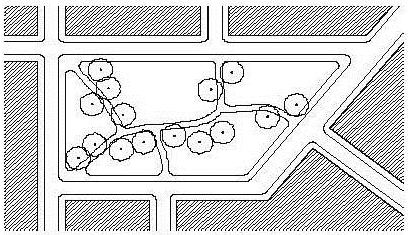
Figure VII-13: Green
b.
Plazas.
i.
Plazas shall have more than 50 percent of their property lines surrounded by nonresidential uses.
ii.
Exclusive of dedicated rights-of-way, the minimum impervious surface area is 50 percent and the maximum impervious surface area is 75 percent. The pervious surface areas shall consist primarily of sod, trees that are regularly spaced and garden structures. The impervious surfaces shall consist of paved areas, permanent architecture such as archways, statues and gazebos or water-oriented features.
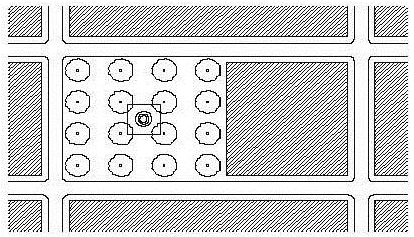
Figure Vii-14: Plaza
c.
Squares.
i.
Squares shall be flanked by streets on at least three sides.
ii.
Exclusive of dedicated rights-of-way, the maximum impervious surface area is 50 percent. The pervious surface areas shall consist primarily of sod and trees that are regularly spaced. The impervious surfaces shall consist of hard-surfaced walks.
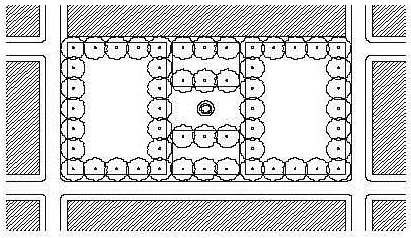
Figure VII-15: Square
(l)
Designated public urban greenways systems . The designated public open spaces and urban greenways systems regulating plan as shown in Figure VII-3 designates the location of the required public urban greenways system throughout NMUD. The designated public urban greenway is the area within the public right-of-way within NMUD. The designated public urban greenways system shall be designed to enhance the visual character of specific streets along the urban greenways and ensure pedestrian connectivity by:
a.
Providing street furnishings such as benches, trash receptacles, bike racks, drinking water fountains, etc.
b.
Providing tree species that provide continuous shade for a minimum of 70 percent of the frontage along the urban greenways. Palm trees alone are not acceptable and the maximum spacing of the shade trees shall be 30 feet on center.
c.
Providing a landscape plan illustrating a coherent design with significant tree species along the urban greenways that are distinguishably different from the other streets along the property in terms of color, type and shape.
d.
At the time of planting, the tree shall be a minimum of 20 feet tall.
e.
The public urban greenway must be installed by the adjacent property owner or developer at such time that the property is developed or that renovations to the existing building exceed 50% of the value of the existing building. The maintenance of the urban greenway is the responsibility of the adjacent property owner.
(m)
Street network connectivity regulating plan and street standards . The Street Network Connectivity Regulating Plan as shown in Figure VII-4 shows the location of existing and required new streets needed to create the prescribed network of streets within the NMUD. This plan also establishes the hierarchy of the streets within the district. The hierarchy of streets is Primary A, Primary B, Secondary A, Secondary B, Tertiary A, Tertiary B, Tertiary C and Alley. In addition, the following shall apply:
(1)
All streets shall be located according to the street network connectivity regulating plan.
a.
All City controlled Primary A and B Streets, Secondary A Streets and City controlled Tertiary A and B Streets shall be required in the same general location as shown on the Street Network Connectivity Regulating Plan and may be modified with respect to alignment, provided that the final alignment is approved by the City Commission and maintains the street network connectivity. No Primary A and B Streets, Secondary A Streets and Tertiary A and B Streets shall be deleted or otherwise vacated or removed.
b.
24 th Street and Northwood Road, west of Broadway Avenue, as shown on the Street Network Connectivity Regulating Plan, may be modified or deleted for the purpose of assembling parcels for development and/or parking.
c.
Alleys shown on the Street Network Connectivity Regulating Plan are encouraged to promote connectivity and to conform to block length requirements. Type B Alleys only, as shown on the Street Network Connectivity Regulating Plan, may be modified or deleted for the purpose of assembling parcels for development and/or parking.
(2)
The modification, improvement or deletion of Secondary B Streets and Alleys, where permitted on the Street Network Connectivity Regulating Plan as shown in Figure VII-4, requires the following conditions are satisfied:
a.
The modification/improvement/deletion is reviewed and recommended by the director of development services who shall review the proposed modification for compliance with these regulations.
b.
The modification/improvement/deletion is reviewed and recommended by the community redevelopment agency who shall review the proposed modification for compliance with redevelopment plans and objectives.
c.
The modification/improvement/deletion is reviewed and recommended by the city administrator or director in charge of engineering who shall review the proposed modification for traffic and safety issues.
d.
The modification/improvement/deletion does not diminish the general size and location of an open space shown in the designated public open space and urban greenways systems regulating plan.
e.
The modification/improvement/deletion maintains connectivity to the surrounding area.
f.
The modification/improvement/deletion enhances pedestrian safety.
g.
The modification/improvement/deletion is compatible with the surrounding area.
h.
The modification/improvement/deletion allows for the appropriate use of private property.
i.
The modification/improvement/deletion does not create block lengths that exceed the maximum allowed in Section 94-209 Mixed-use (MU) District, thereby limiting walkability.
j.
The modification/improvement/deletion complies with the requirements for vacating and closing streets and alleys, as applicable, in accordance with chapter 78, Article VII of this Code.
(3)
The design of new streets and modifications of existing streets shall comply with the following requirements:
a.
All streets and alleys shall connect to other streets or alleys. Cul-de-sacs, T-turnarounds, and dead end streets are prohibited.
b.
Private streets must permit access to the general public. The public access allowance must be recorded in the public record as part of a plat or separate instrument that is approved by the City Attorney. Streets may not be gated to impede through traffic.
c.
Where there is insufficient area for the streetscape improvements within the existing right-of-way, the City may, at its discretion, require an easement or dedication so that the full area for the streetscape improvements is provided by the developer. Additionally, the development and ongoing maintenance of the required streetscape improvements along the entire property frontage shall be the responsibility of the developer/property owner. A maintenance agreement with the City is required.
d.
All non-Florida Department of Transportation streets shall be designed according to the typical street sections provided in Figures VII-16 thru VII-19. Additionally, the following standards shall apply to all streets:
i.
A minimum landscaped strip of five feet shall be provided along the curbside at the street edge.
ii.
Tree grates, a minimum of five feet by five feet, may be utilized in place of the required landscape strip. The use of tree grates is appropriate when on-street parking is provided. When no on-street parking is provided, landscape strips are preferred.
iii.
A minimum sidewalk width of five (5) feet shall be provided adjacent to the landscaped area.
iv.
A minimum unobstructed area of 60 inches shall be provided in the sidewalk.
v.
A continuous, unobstructed area of at least ten feet in width is required within a colonnade
vi.
No utility poles, fire hydrants or any other temporary or permanent structures shall be permitted within the unobstructed area.
vii.
Overhead utilities are not permitted. Existing overhead utilities shall be relocated underground, where feasible.
viii.
Where on-street parking is provided on both sides of the street, the minimum right-of way width shall be 60 feet.
ix.
All travel lanes shall be a maximum of ten feet in width unless otherwise required by the city's traffic engineer.
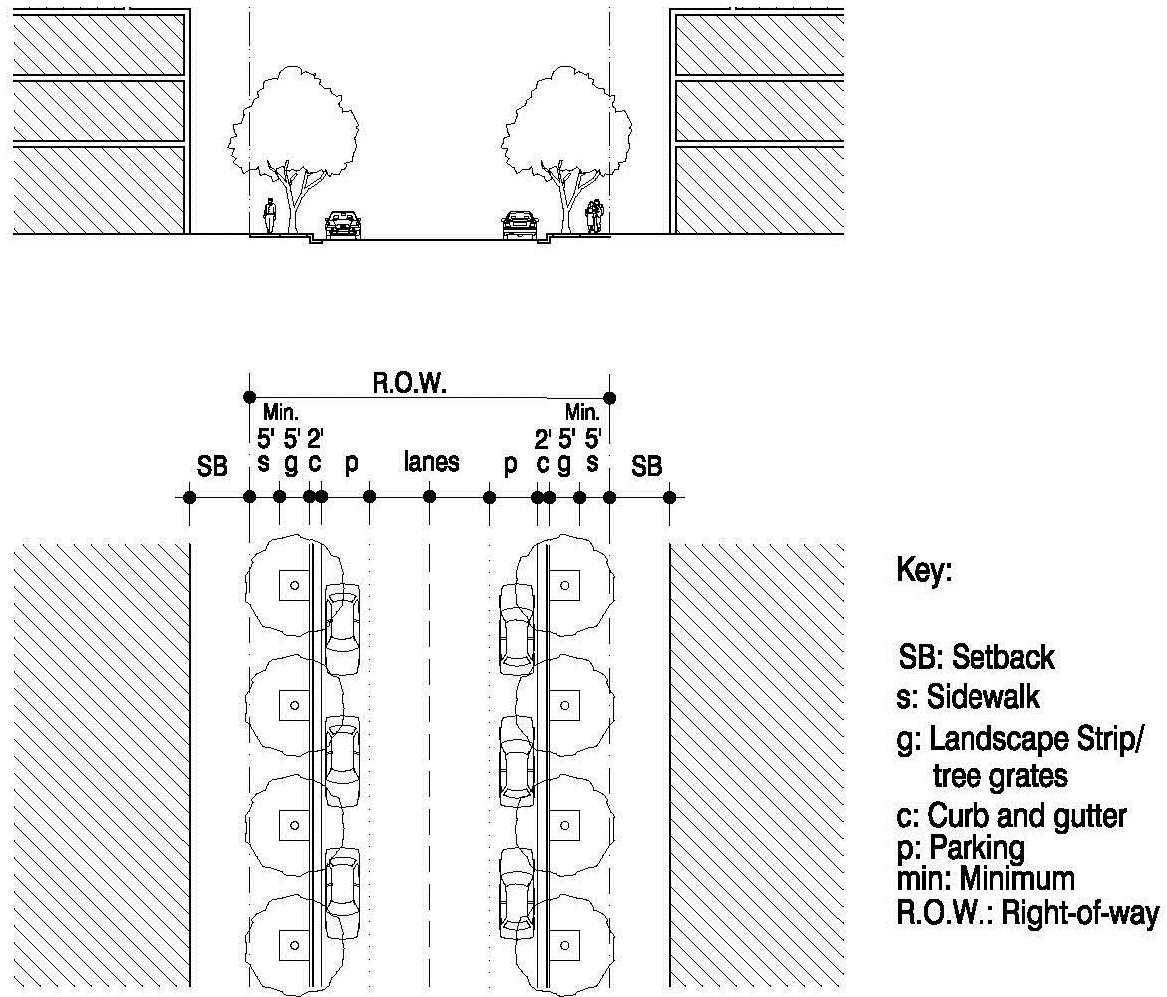
Figure VII-16: Typical street section with parking on both sides
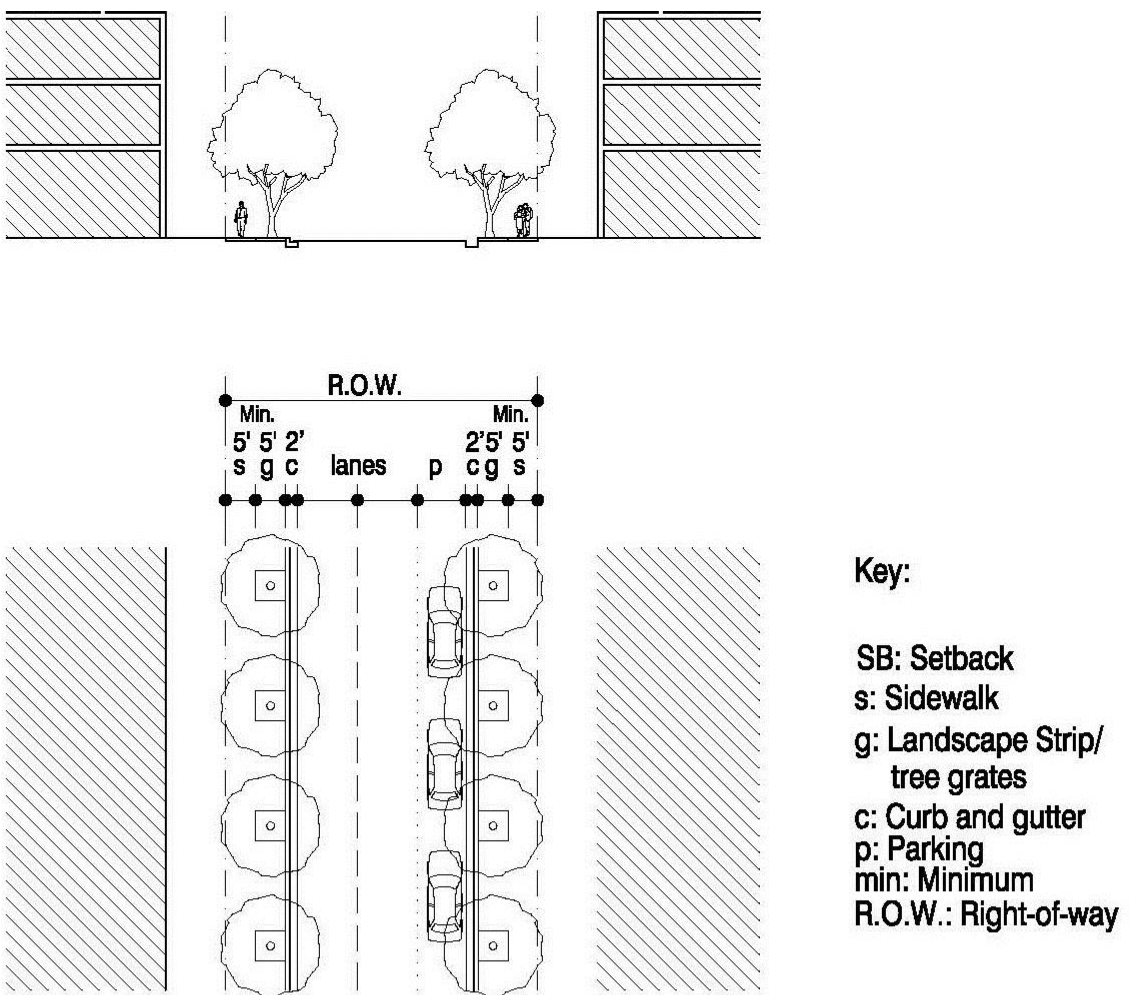
Figure VII-17: Typical street section with parking on one side
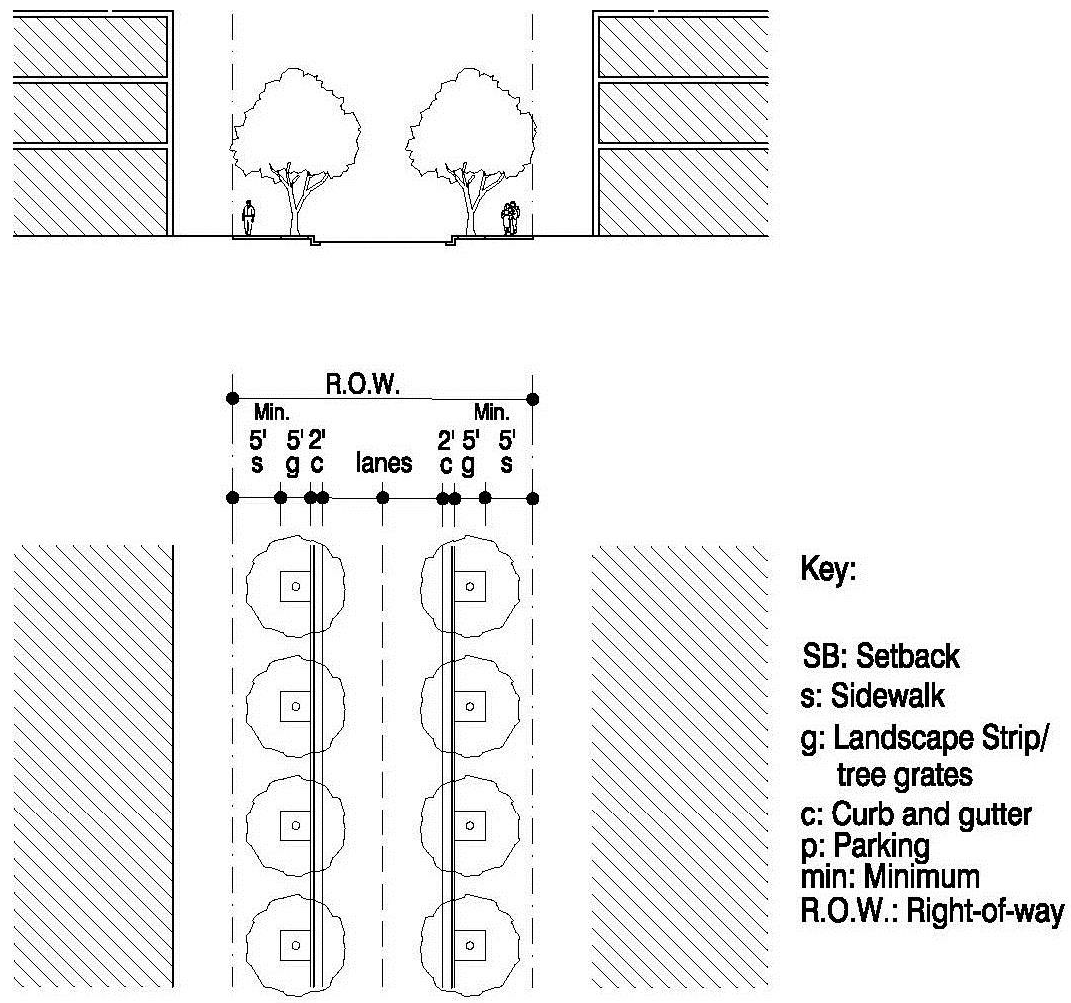
Figure VII-18: Typical street section with no parking
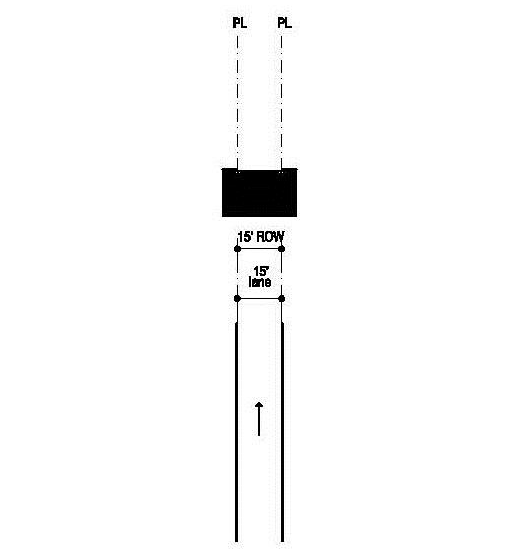
Figure VII-19: Typical street section for one-way alley
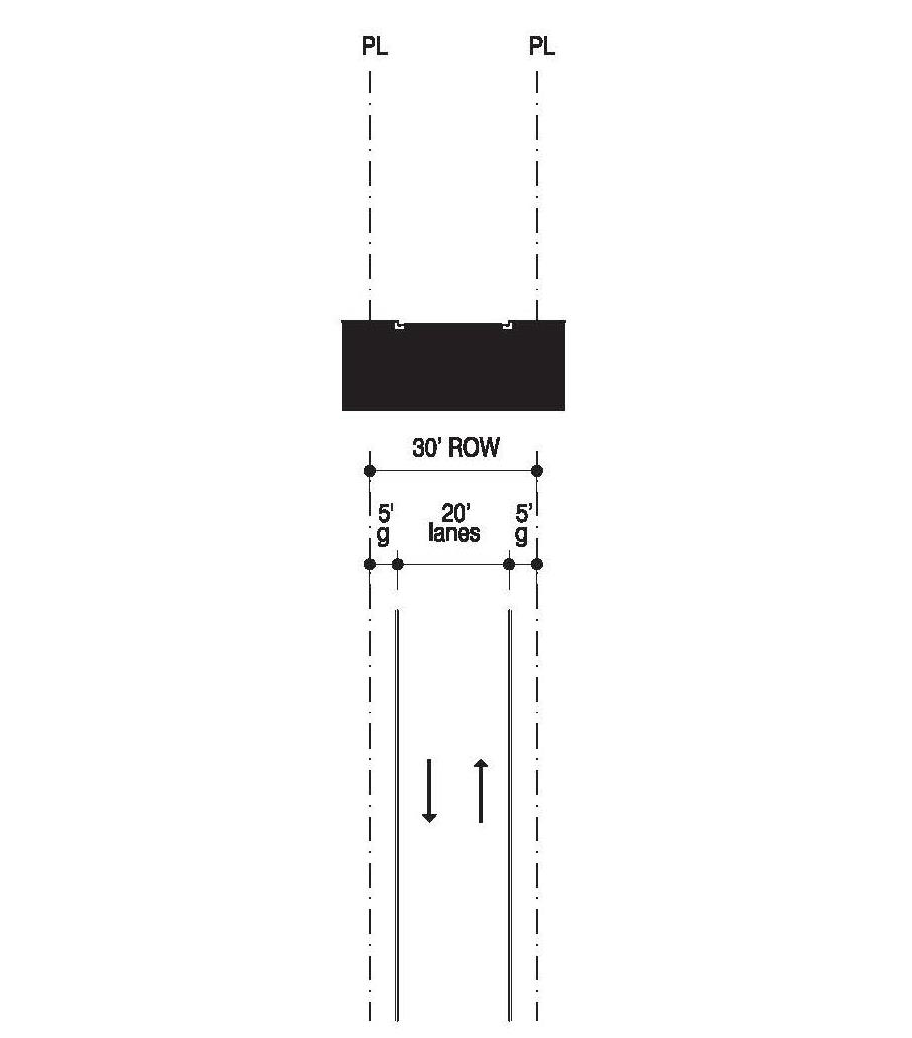
Figure VII-20: Typical street section for two-way alley
(n)
On-site parking standards .
(1)
All parking within the NMUD shall comply with the access, circulation, parking and loading standards specified in section 94-209 Mixed-use (MU) District.
(2)
On-site parking shall comply with Table VII-10. For institutional uses and single-family residences, parking shall comply with Table XV-6.
(3)
Guest parking shall comply with Table VII-10. Guest parking shall be designated and prominently marked on-site as "Guest Parking" and shall not be restricted in any manner to use by a single tenant, owner, unit, or other user.
(4)
On-street parking along the corresponding frontage lines may count towards the on-site parking requirement, provided that it complies with the provisions of Section 94-485(b)(2).
(5)
For non-residential developments a maximum of 100 percent of the required on-site parking may be located off-site.
(6)
For non-residential developments a maximum of 100 percent of the required on-site parking may be provided as tandem parking when valet service is provided; however, required ADA parking spaces must be provided to permit users to self-park in space meeting all ADA parking requirements. In those cases where the valet service utilizes existing or proposed on-street parking for drop-off or pick-up, the applicant shall pay for the use of those occupied spaces in the amount as established by the city and in locations approved by the city parking administrator.
Table VII-10: Minimum and Maximum
Parking Requirements by useMin Max Retail, restaurant or commercial 2 per 1,000sf 4 per 1,000sf Office 2.5 per 1,000sf 4 per 1,000sf Hotel and motel; hotel and motel, limited 1 per 4 rooms plus 1 per 800sf for restaurant, public meeting areas; 1 per 15 rooms for staff 1 per 4 rooms plus 1 per 800sf for restaurant, public meeting areas; 1 per 15 rooms for staff Multi-family Residential 1 per unit plus 1 per 20 units for guest parking 2 per unit plus 1 per 20 units for guest parking Live/work 2 per 1,000sf 4 per 1,000sf (o)
Bicycle racks and bicycle storage . Bicycle racks and storage shall be required as follows:
(1)
Bicycle racks and bicycle storage for commercial uses . Commercial developments, shall provide:
(i)
Secure bike racks and/or storage at a ratio of one bicycle parking space per every 10 required parking spaces; and
(ii)
A minimum of one shower and changing facility shall be provided to be available for all tenants and shall be located within the building, or within 200 feet of the building entrance, for developments greater than 50,000 square feet in gross building area.
(2)
Bicycle racks and bicycle storage for residential uses . One bicycle parking space shall be provided per every 10 required parking spaces. Required residential bicycle parking spaces shall be provided in a secured area, covered from the elements.
(3)
Mixed-use developments . Mixed-use developments shall provide secure bicycle parking spaces for both the commercial and residential components of the development as calculated separately pursuant to the requirements of this section.
(p)
Additional standards .
(1)
Design standards . All development within the NMUD shall comply with the Design Standards specified in section 94-209 Mixed-use (MU) District. Additionally, exterior finish material shall be of a high architectural quality such as stone, brick, stucco, pre-cast concrete, clapboard siding, and wood shingles.
(2)
Accessory dwelling units .
a.
Accessory dwelling units shall only be permitted in association with the Townhouse and Zero-Lot Line building types and shall be detached from the primary residence.
b.
The total floor area of an accessory dwelling unit shall not exceed 800 square feet.
c.
The height of the detached garage with a dwelling unit above shall not exceed 25 feet.
d.
The accessory dwelling unit structure shall be in compliance with any location and design standards for the Townhouse and Zero-lot line building types as shown in Figures VII-10 thru VII-12.
e.
One parking space shall be provided for the accessory dwelling unit in addition to the minimum required parking for the principal structure.
(3)
Colonnades .
a.
Colonnades built to satisfy building frontage requirements shall be attached to the principal structure.
b.
In no case shall the depth of the colonnade exceed the colonnade's height.
c.
The finished floor elevation of the colonnade shall match the adjoining sidewalk, when applicable.
d.
Colonnade height shall generally align with and be limited to the ground floor/story building height and shall not have enclosed uses above.
e.
Colonnades shall have a consistent depth which generally matches those of neighboring building colonnades or arcades, if present
(4)
Signage .
a.
A single external sign band may be applied on the facade of each building provided that it shall not exceed 36 inches in height by 60 percent of the width of each side of the building. This sign band shall be located within the first two stories of the building. If the storefront uses awnings, the copy or logo on the valance shall not exceed six (6) inches in height and shall be considered as square footage against the allowable building signage.
b.
Sign bands facing a residential zoning district shall not exceed 1.5 feet in vertical dimension by 30 percent of the facade width. The illumination of the sign shall be directed only toward the sign face. This sign band shall be located on the ground floor only.
c.
Pedestrian blade signs may be attached perpendicular to the building façade extending up to four feet and not exceeding three feet in vertical dimension and must provide a minimum of eight feet of clearance from the sidewalk grade. One pedestrian blade sign is permitted for each business with a door at the sidewalk level. The illumination of pedestrian blade signs shall be directed toward the sign face only.
d.
Signs painted directly onto a facade are prohibited. Murals that are painted directly onto a façade require the submittal of a building permit to the City.
e.
Signs pertaining to special sales, events or services may be affixed to the inside of windows provided that the total area does not exceed 15 percent of the window area. Such signs shall not remain in place for more than 30 days.
f.
All fasteners shall be concealed. Exposed raceways, transformers, ballasts and electrical wiring are not allowed. No signs with visible backs are permitted.
g.
All installation components or hanging devices such as, but not limited to, fasteners, clips, bolts, etc. shall be of non-corrosive, stainless steel, aluminum, brass or bronze; carbon bearing steel shall be of non-ferrous metal of quality material and finish. All black iron materials shall be finished to withstand corrosion. All penetrations of the fascia shall be neatly sealed in a watertight manner using a single component silicon sealant. All signage shall have an individual circuit and be controlled by a time clock. Exposed conduit or electrical wiring is prohibited. Internally illuminated panels are prohibited.
h.
Each business is allowed a maximum of one neon sign.
(5)
Rooftop terraces . These regulations are intended to guide the non-habitable use of rooftops for buildings built to the maximum story height limit to allow rooftop terraces. Rooftop terraces and rooftop amenities, such as roof gardens, observation decks, swimming pools, and running tracks, are encouraged to create unique gathering spaces, to aid in the reduction of the urban heat index in the Northwood mixed-use district area, and to add aesthetic value to the buildings. Rooftop terraces are not intended to add additional story height for uses that could otherwise occupy space within the building, such as, but not limited to, fitness centers, restaurants, locker rooms, and other similar amenities. Rooftop terraces shall be subject to the following criteria:
a.
Rooftop terraces shall be architecturally compatible with the design of the overall building.
b.
Rooftop terraces that are entirely open to the sky may occupy 100 percent of the total gross roof area.
c.
Rooftop terraces shall be hardscaped with materials such as, but not limited to, patterned concrete, pavers, or wood decking.
d.
Rooftop terraces shall provide shaded seating areas.
e.
Rooftop terraces shall be landscaped over a minimum of 15 percent of the rooftop terrace area. Landscaping shall consist of trees, shrubs, ground cover, and vines.
(6)
Covered structures .
a.
Covered structures above the maximum allowable building height are permitted to cover a maximum area of 30 percent of the gross rooftop area. For the purposes of calculating the maximum area, the term "covered structures" shall not include enclosures for screening mechanical systems.
b.
Covered structures above the maximum allowable building height shall not be designed in any manner that would permit the conversion of such structure from non-habitable to habitable space, and shall not include commercial uses. Covered structures shall be compatible with and in proportion to the architecture of the overall building. The following restrictions apply:
i.
Climate-controlled structures are limited to the minimum area necessary to accommodate uses which are secondary and incidental to the primary rooftop amenity. These structures may include saunas and steam rooms and code-required restrooms.
ii.
The supporting restroom facilities shall not exceed 110 percent of the size required by the health department.
iii.
Refreshment service areas are permitted provided such areas do not include cooking facilities and are not climate-controlled.
iv.
Open air structures located on the ground floor shall not be subject to these requirements.
(7)
Swimming pools . Swimming pools and/or whirlpools are permitted in rooftop terraces subject to the following criteria:
a.
Swimming pools and/or whirlpools are permitted provided the top of the surrounding deck does not exceed eight feet above the top of the main rooftop.
b.
Swimming pools and/or whirlpools shall be surrounded by a minimum five-foot wide walkway.
c.
Facilities associated with swimming pools shall comply with the standards for covered structures.
(q)
Historic preservation height bonus assessment .
(1)
Developments utilizing the historic preservation height bonus in accordance with Section 94-210(h)(2) must contribute a historic preservation height bonus assessment per square foot of all additional square footage above base zoning to be eligible for the height bonus. Such historic preservation height bonus assessment shall be paid prior to issuance of a building permit for the new development or addition. All historic preservation height bonus assessments shall be deposited into the historic preservation fund for the Northwood Road Historic District.
(2)
Developments which preserve a historically designated structure on site in accordance with Section 94-210(h)(2)b receive height bonus square footage on a one-for-one basis for the amount of square footage in the preserved building. If the height bonus requires more square footage than is in the preserved building, then the developer shall contribute to the Northwood Historic Preservation Fund in accordance with Section 94-210(q)(1) for the remaining height bonus square footage.
(3)
The amount of the historic preservation height bonus assessment shall be established by resolution of the city commission and may be adjusted from time to time.
(r)
Historic preservation fund .
(1)
A separate historic preservation fund shall be established by the city. All historic preservation height bonus assessment payments from new development or additions to an existing structure within the Northwood mixed-use district shall be deposited into this fund and the funds shall be kept separate from any other city funds. The historic preservation fund shall be used by the city for improvement to and maintenance of structures in the Northwood Road Historic District. Use of such funds shall be determined by the city commission. Any monies not expended in the fund in any fiscal year shall be carried over in the fund into the following year. Any interest earned on the funds shall be retained in the fund.
(s)
Development approval conditions .
(1)
In the Core sub-district, the developer must develop and maintain in perpetuity a minimum of 10,000 square feet of dedicated public open space, as shown on the Designated Public Open Spaces and Greenway Systems Regulation Plan, in accordance with Section 94-210(k).
(2)
In all sub-districts, developers must provide streetscape improvements for the streets within and abutting the property generally in accordance with Section 94-210(m) Street Network Connectivity Regulating Plan and Street Standards.
(3)
In the Core sub-district, the developer must provide Public Parking for the Northwood Mixed-use District. In addition, the following shall apply:
a.
The minimum number of spaces required for off-street parking is provided.
b.
A minimum of ten (10) percent of the parking spaces shall be encumbered for public parking subject to the terms established at the City's discretion. The ten (10) percent of parking spaces shall be calculated including the spaces required for the height bonus and shall be in addition to the parking provided to serve the development.
c.
The public parking shall be unrestricted to public access and located on the ground floor, where feasible, otherwise it shall be located at the lowest level of the garage.
d.
Along each street frontage, where there is an entrance and/or exit to the parking area, one (1) parking sign shall be provided indicating the presence of public parking.
(Code 1979, § 33-88.1; Ord. No. 3915-05, § 2, 12-5-2005; Ord. No. 3976-06, § 2, 11-6-2006; Ord. No. 4072-07, § 2, 10-9-2007; Ord. No. 4772-18, § 5(Exh. C), 5-21-2018; Ord. No. 4780-18, §§ 4, 5, 6-18-2018)